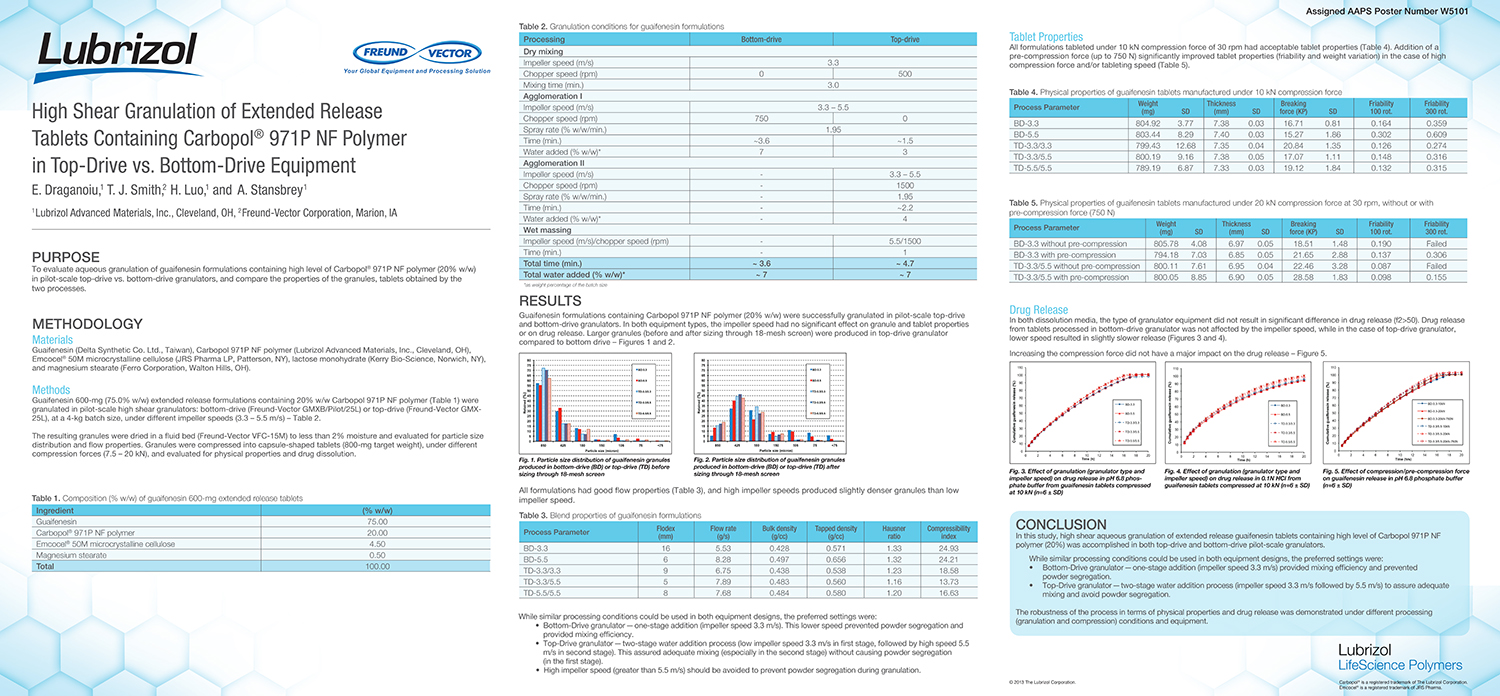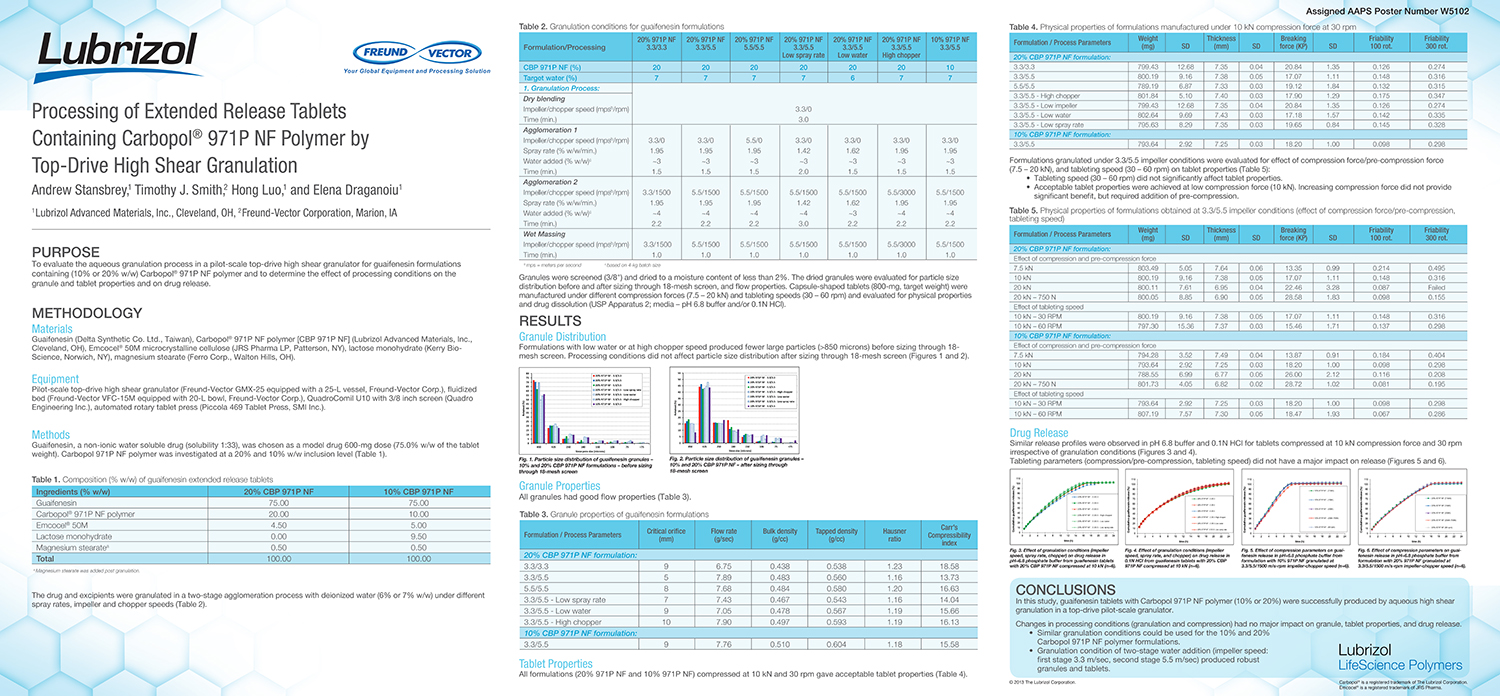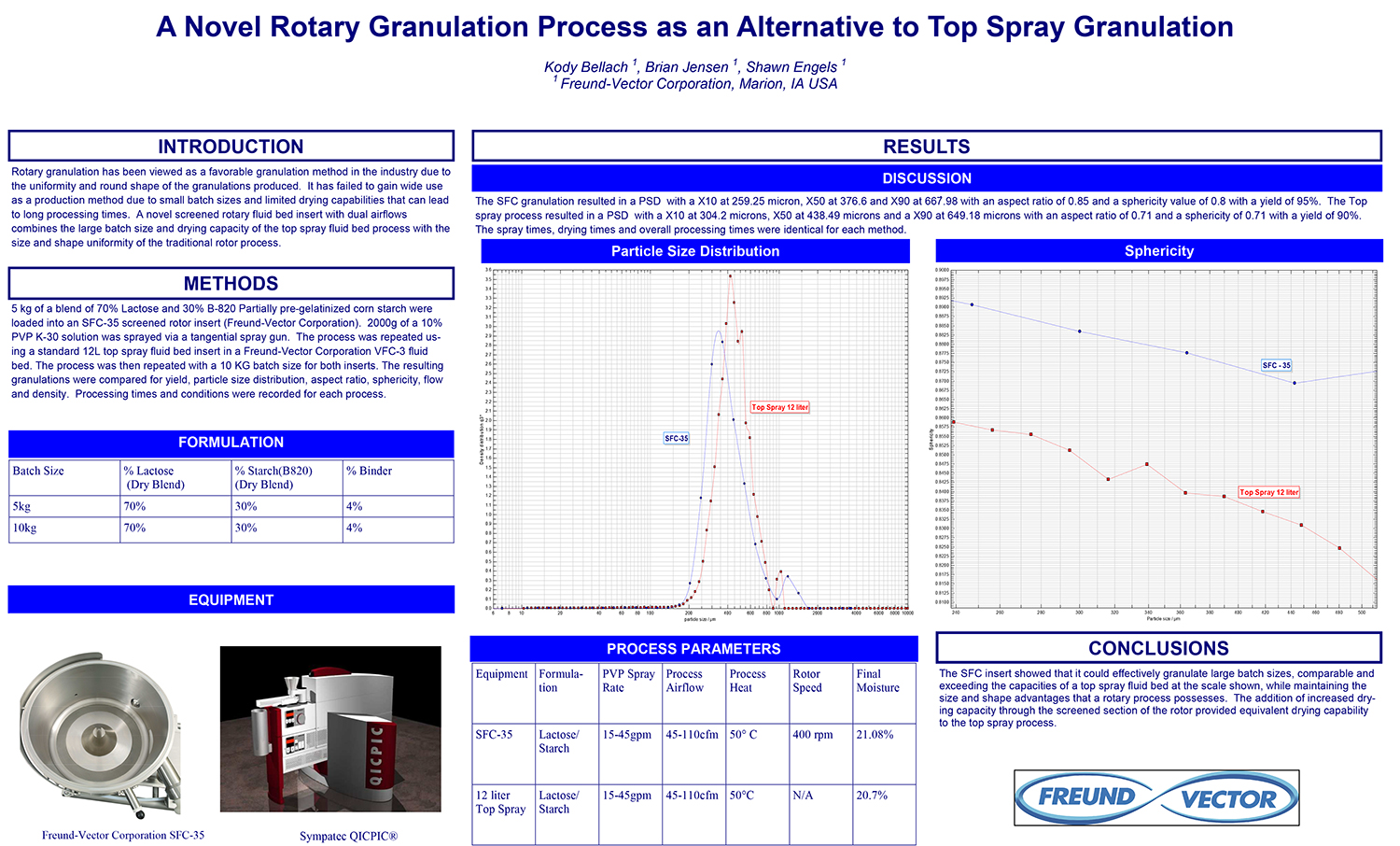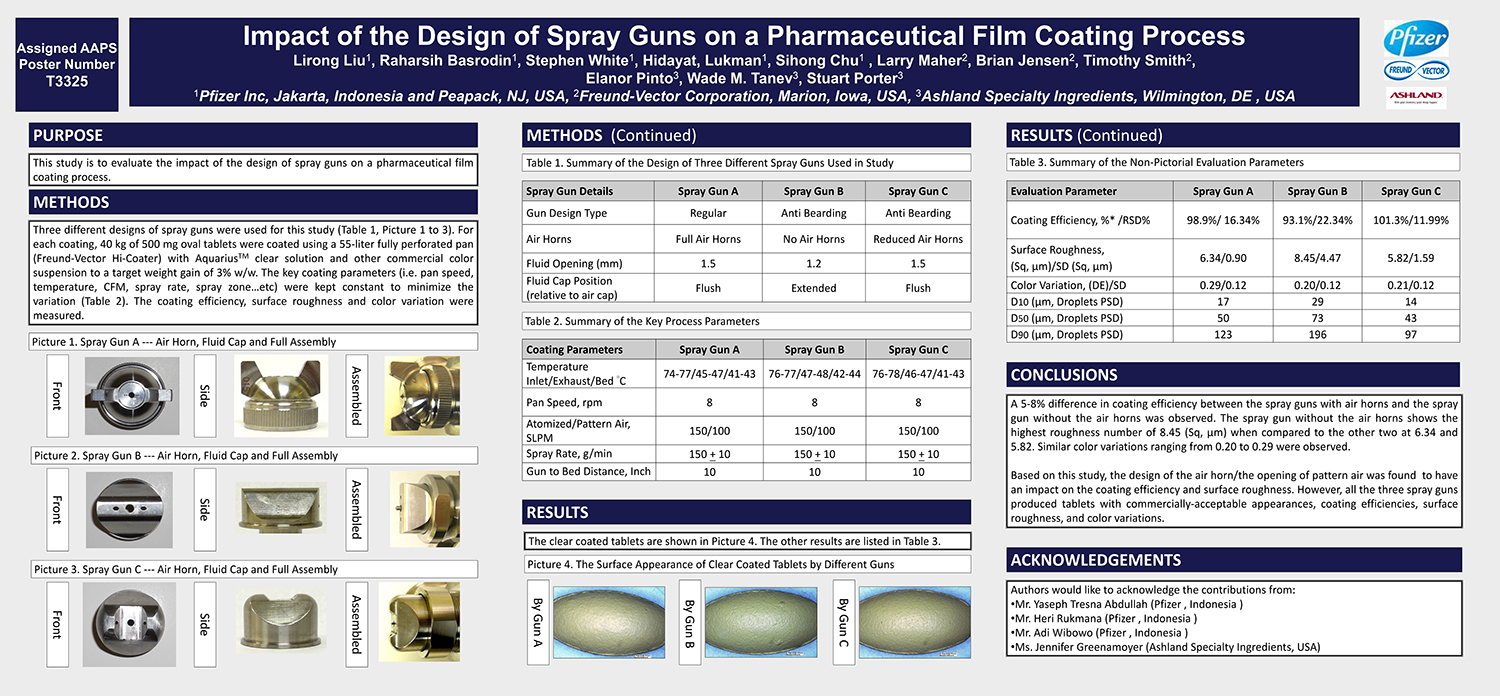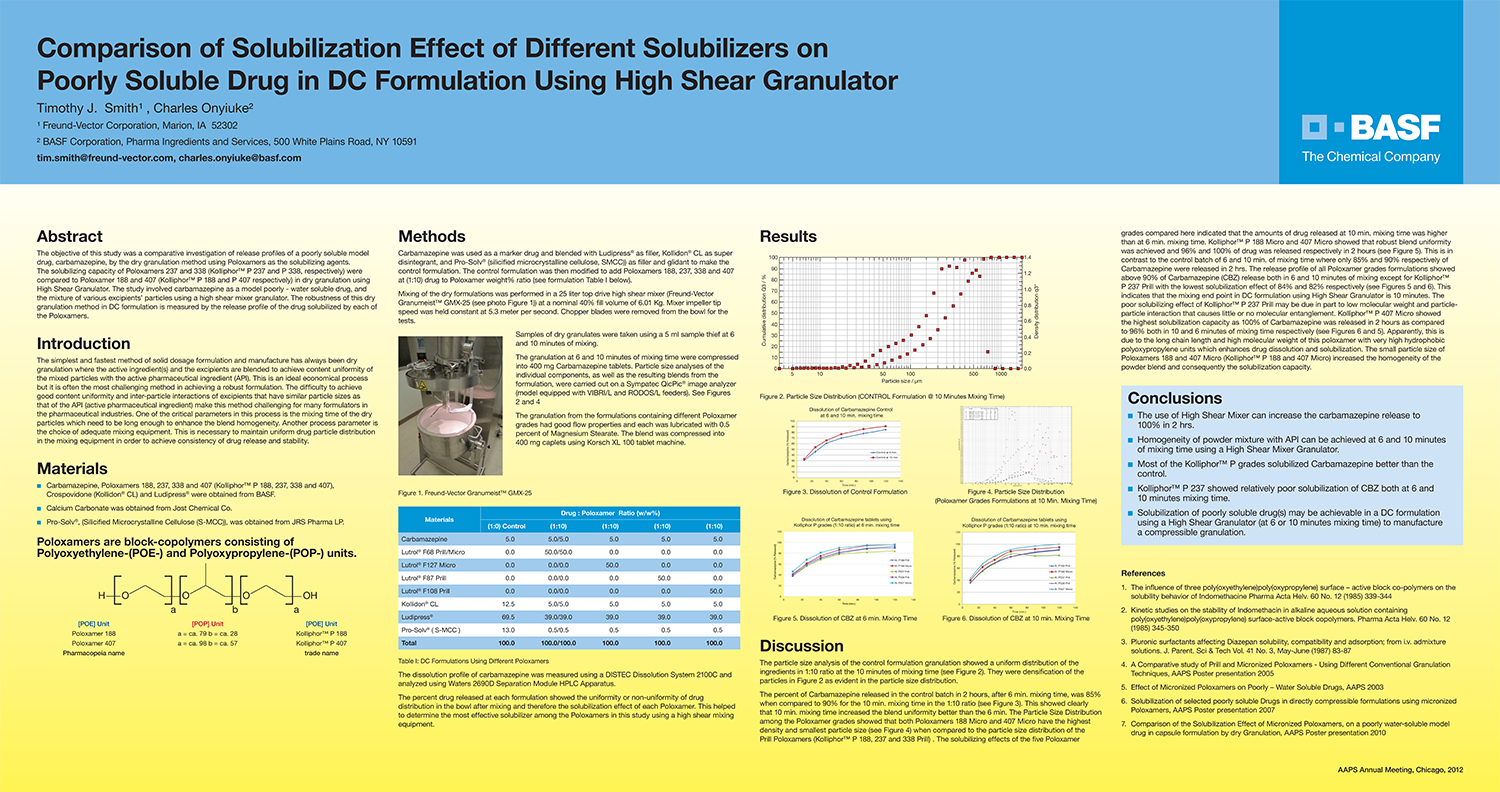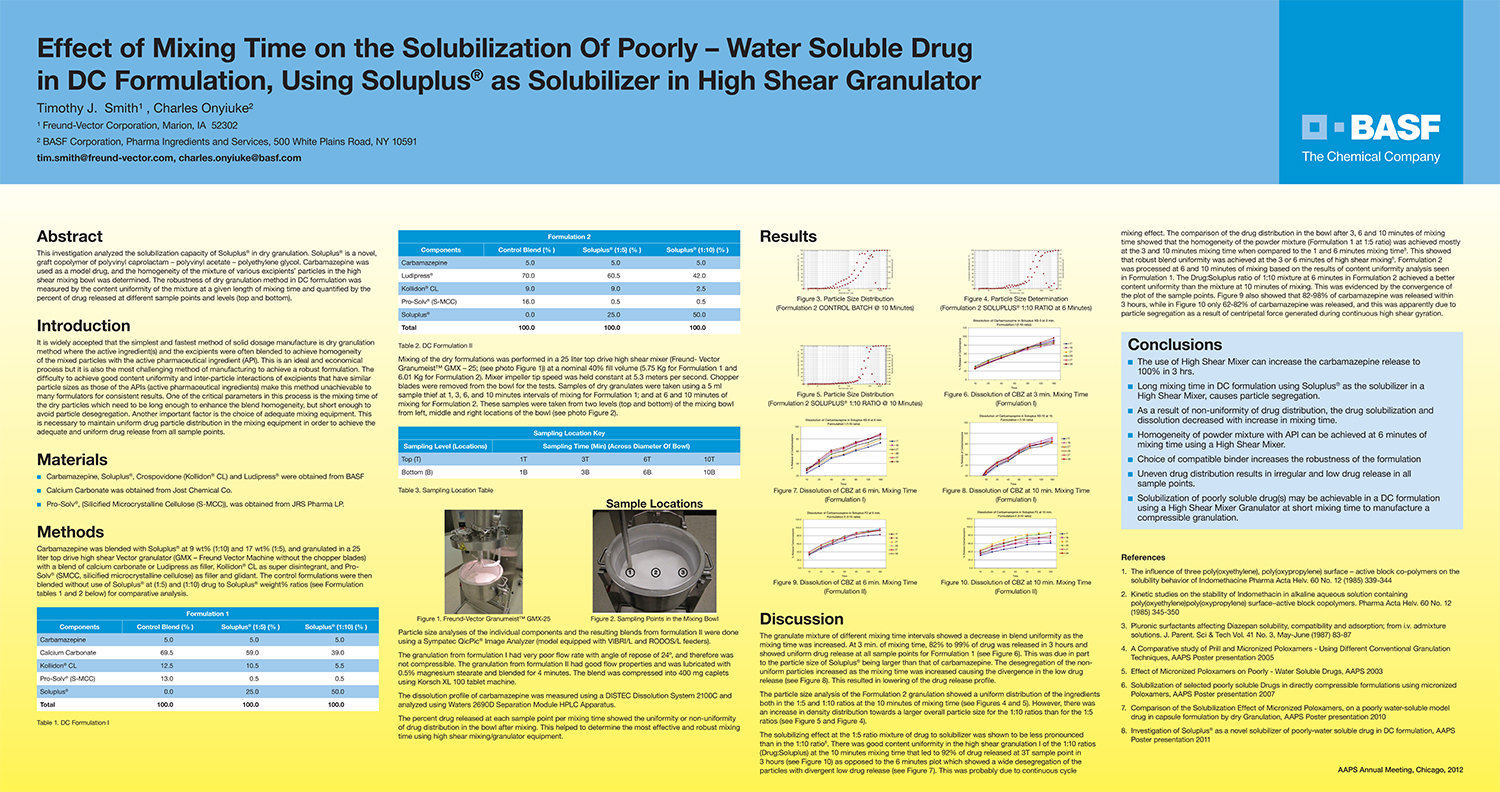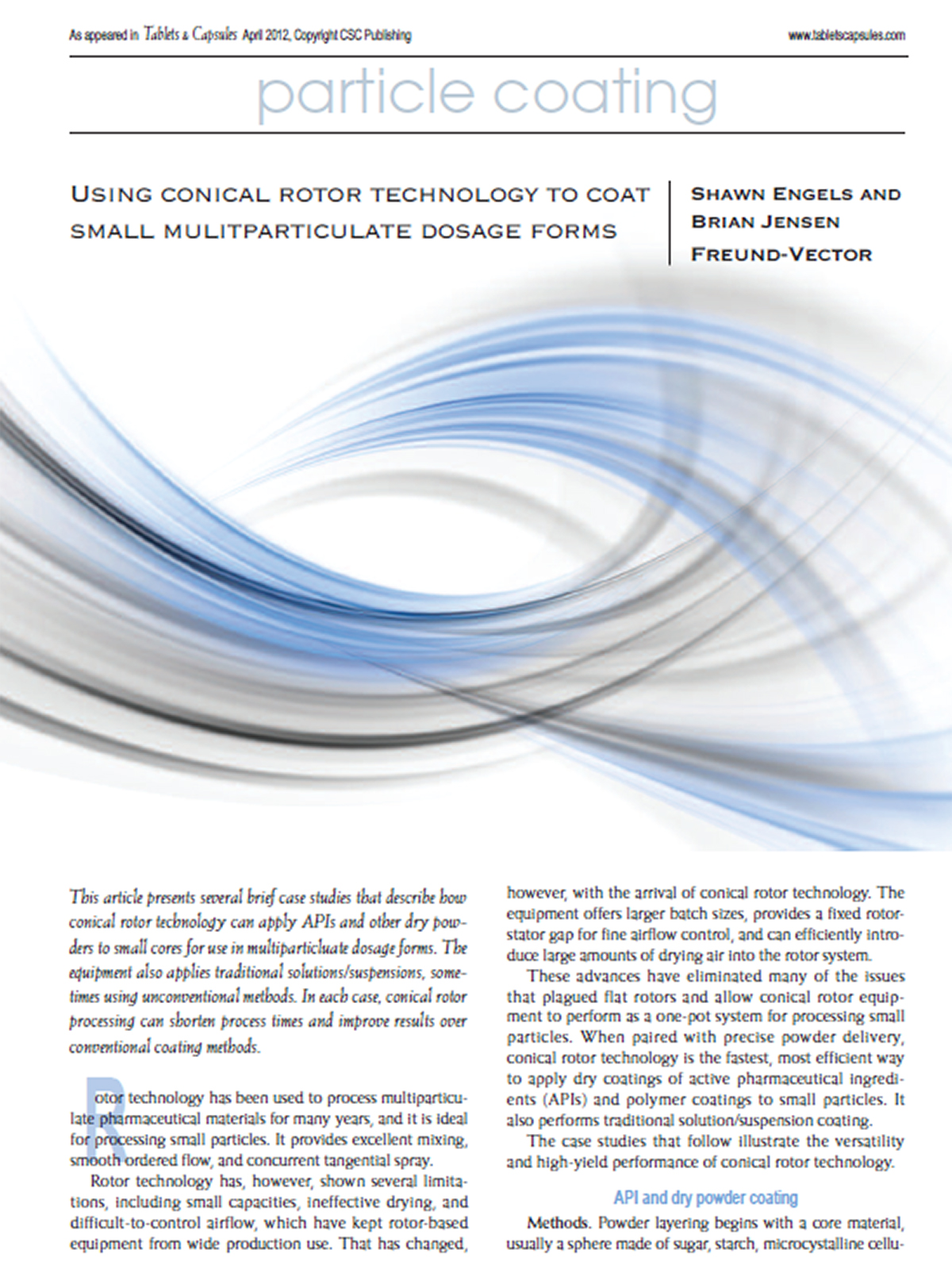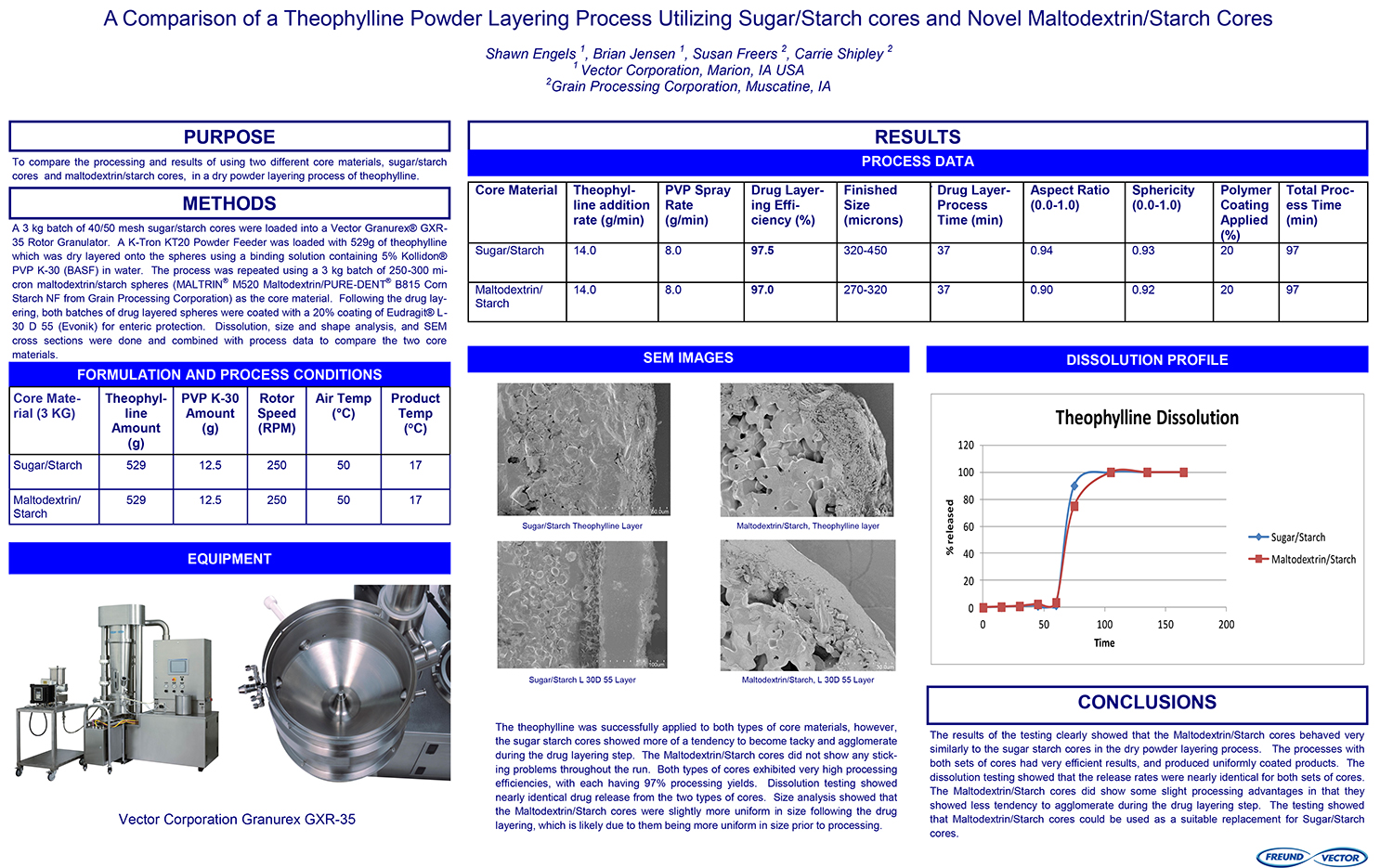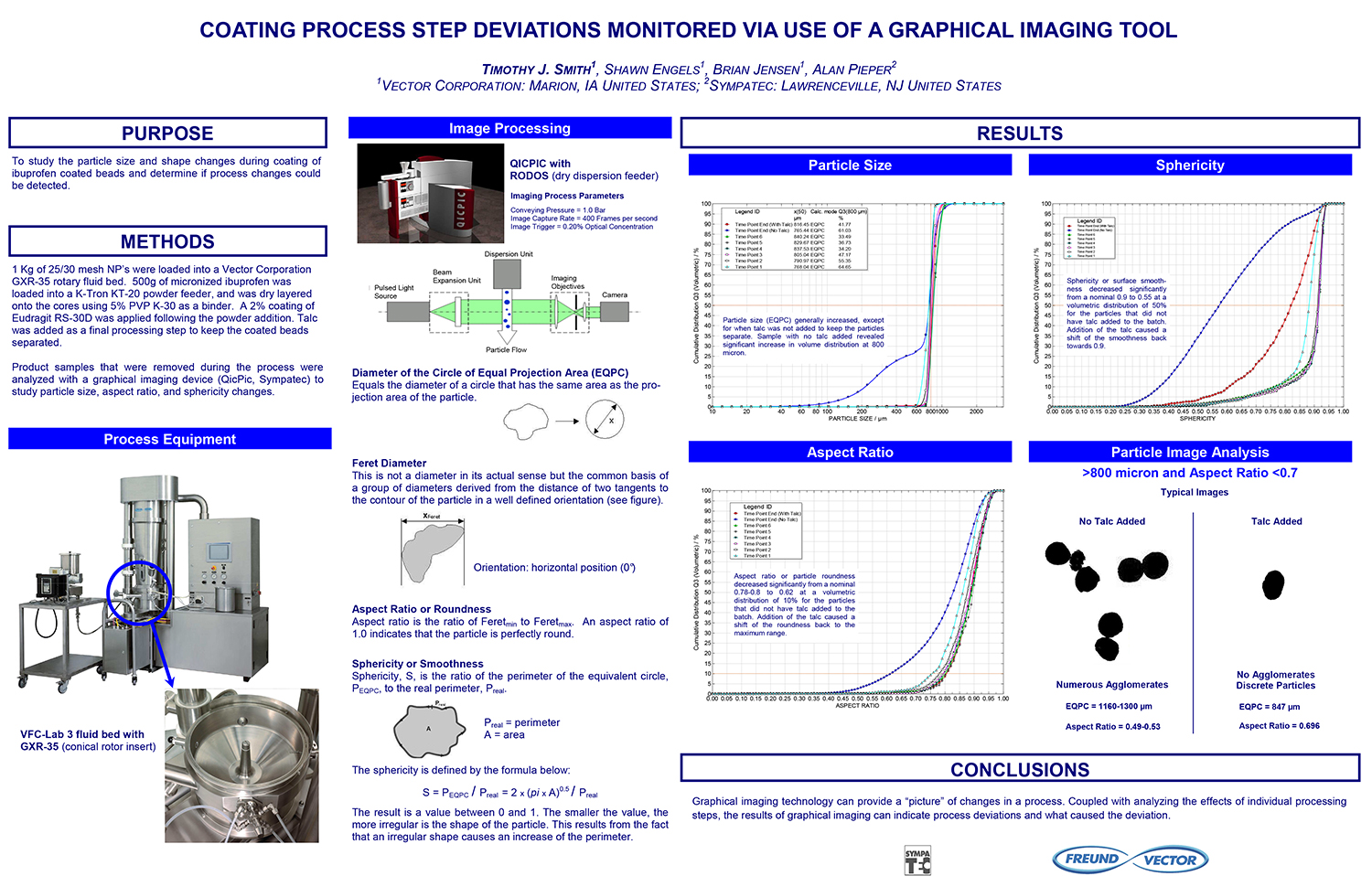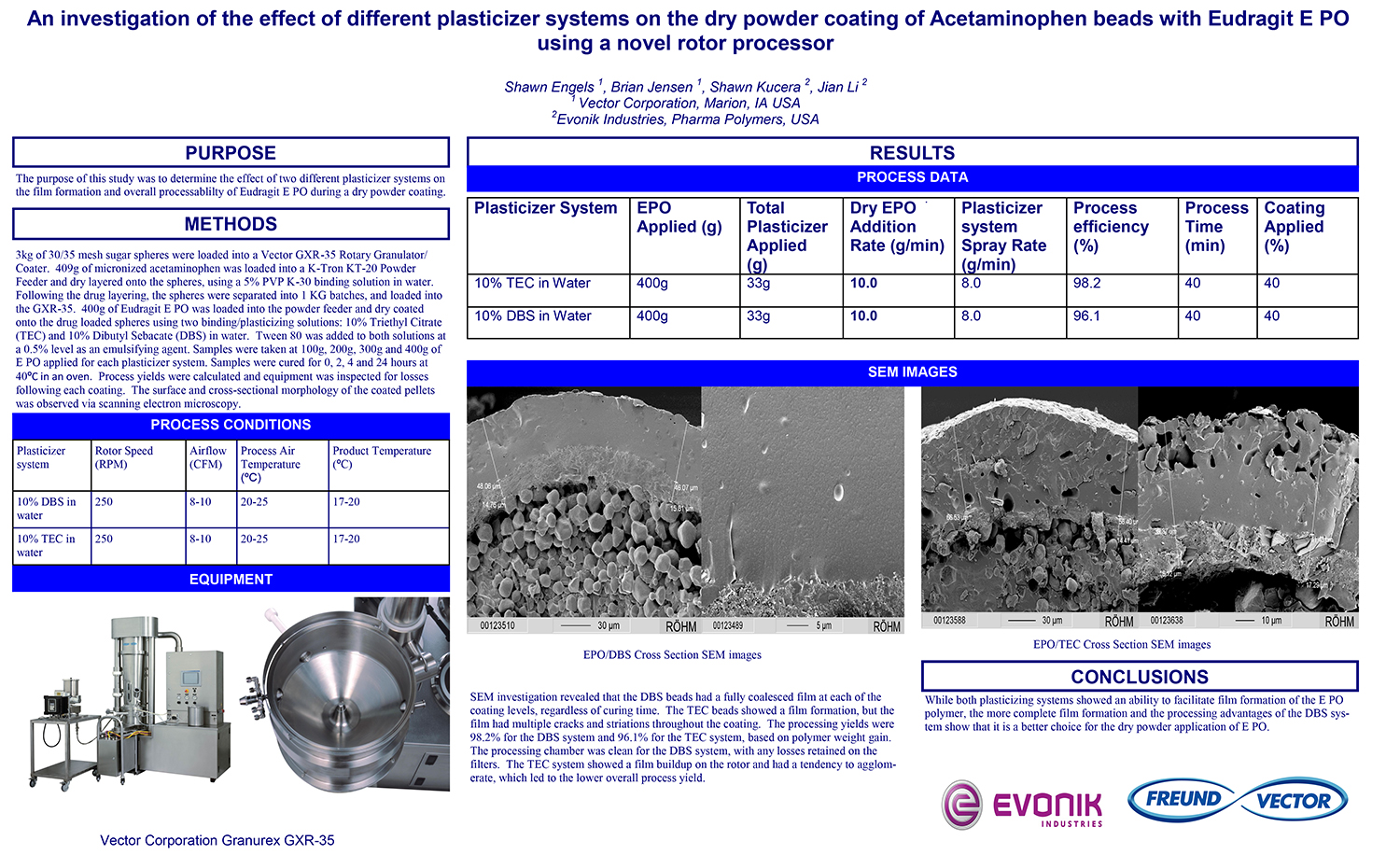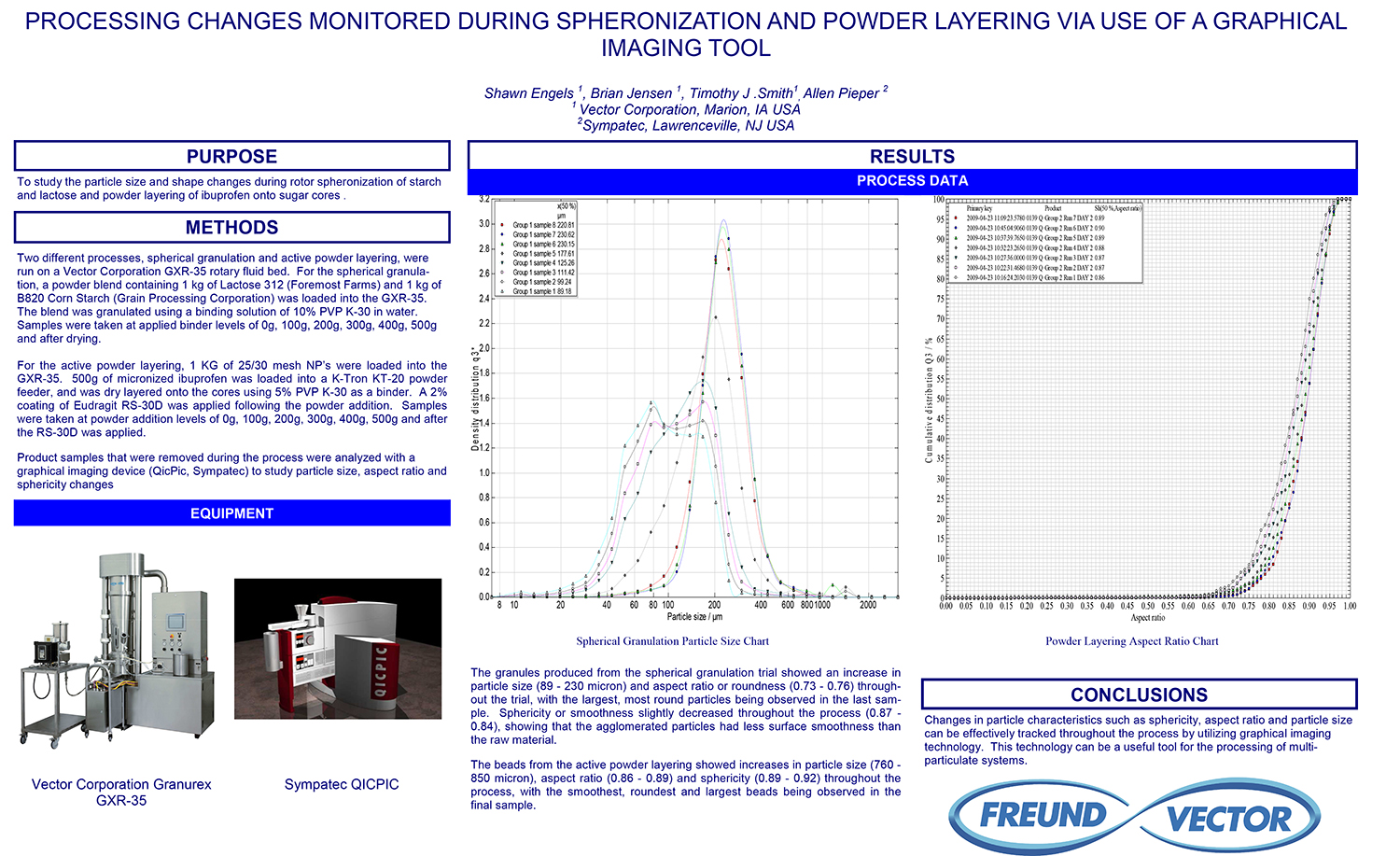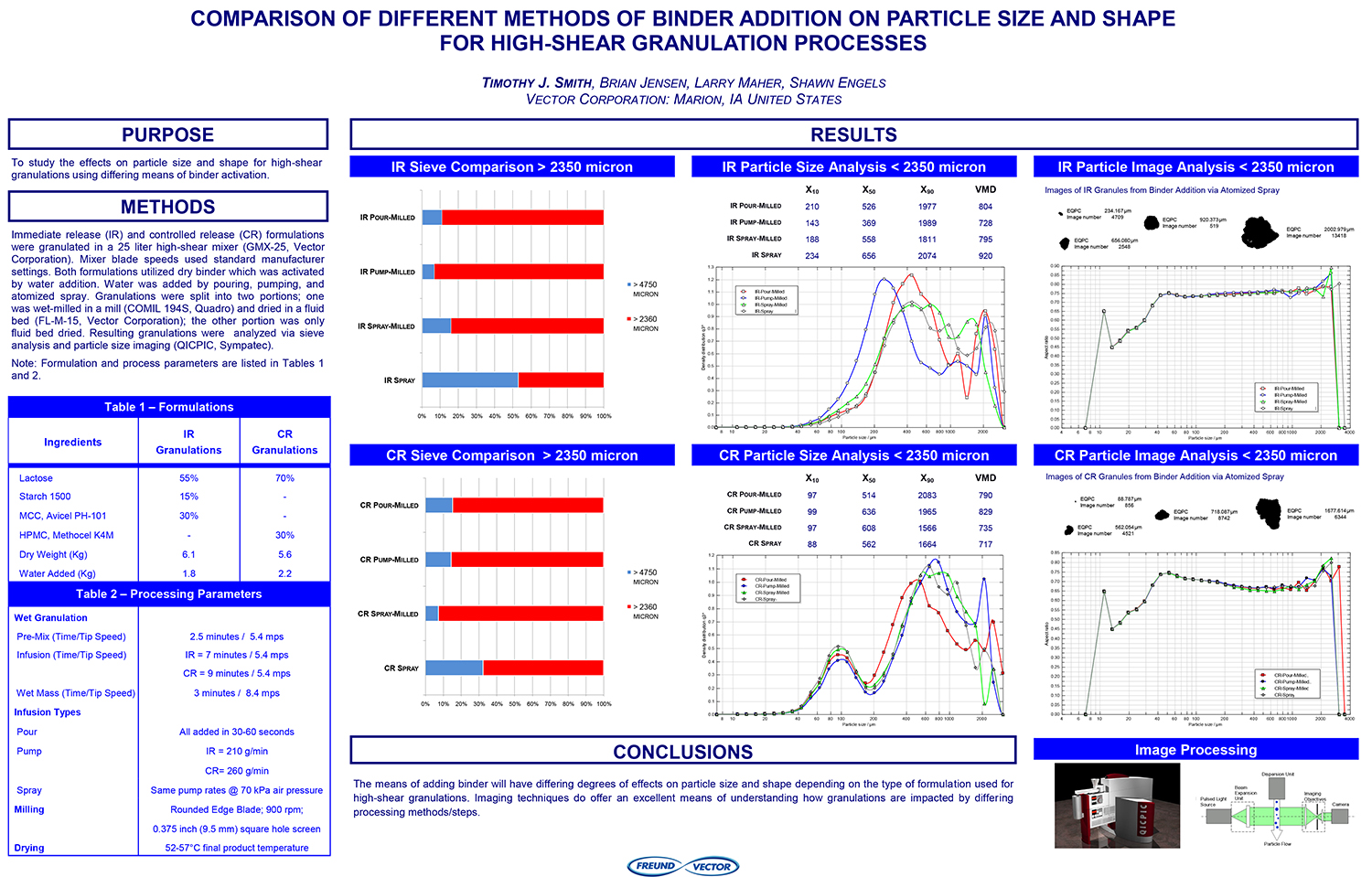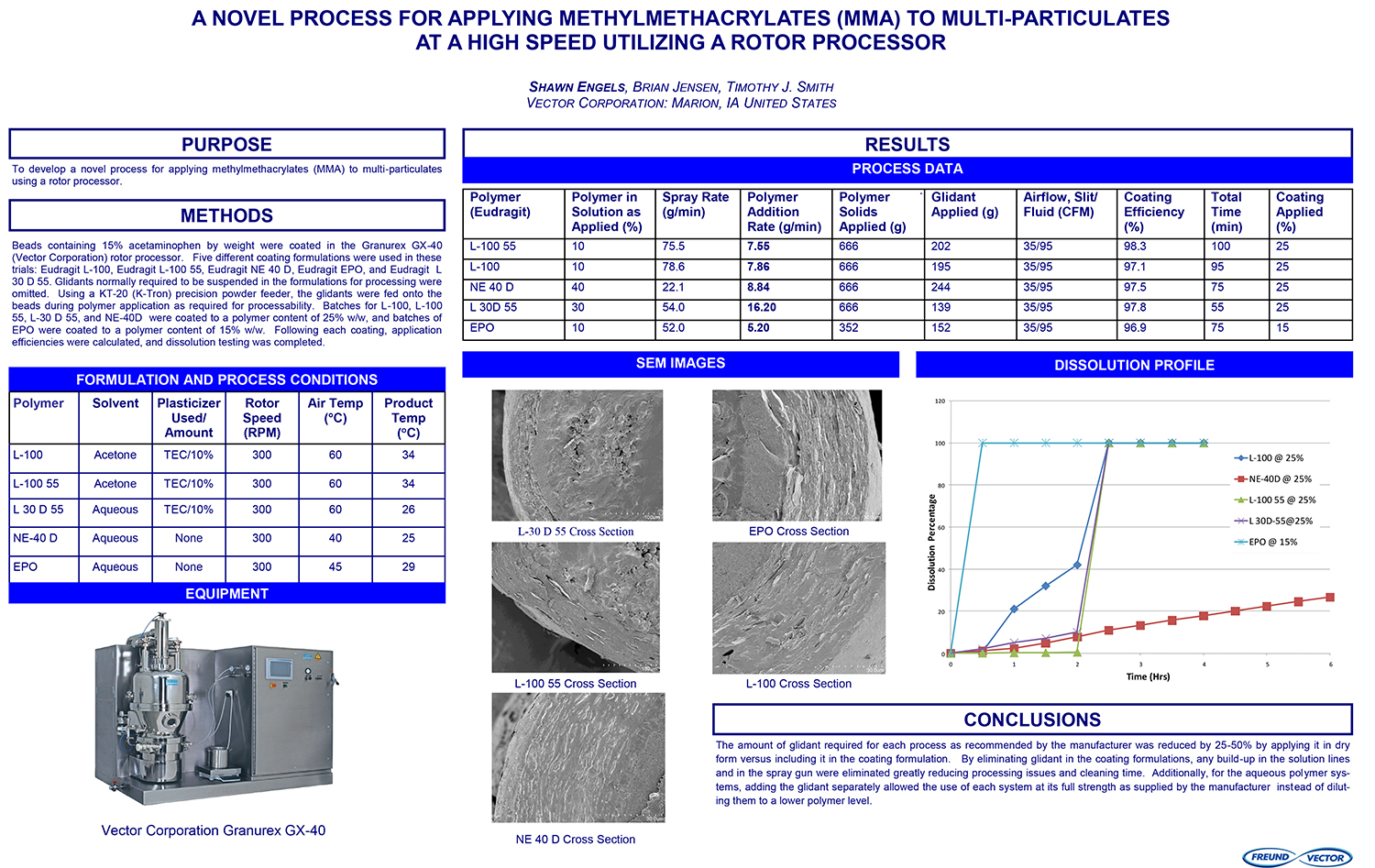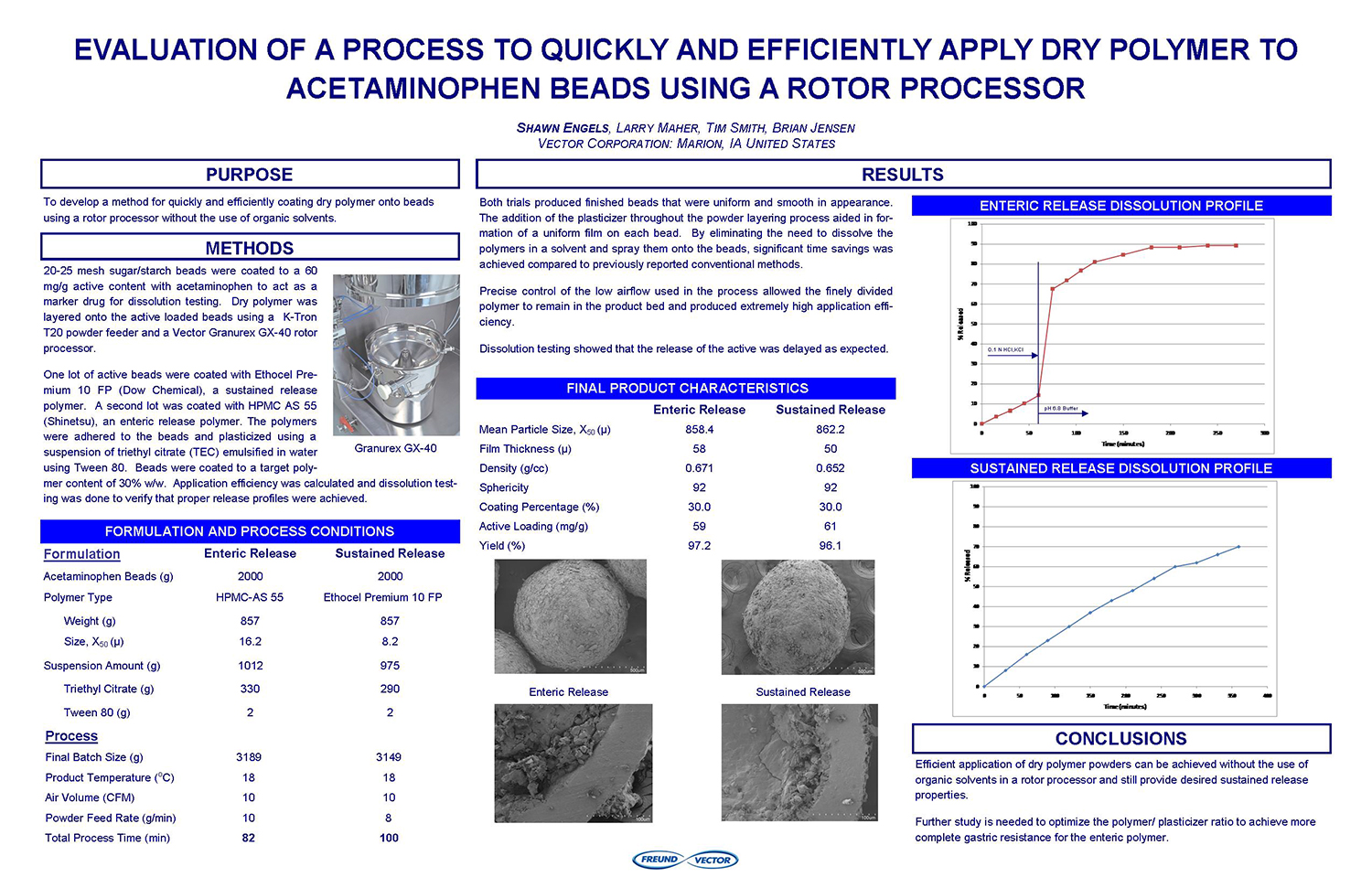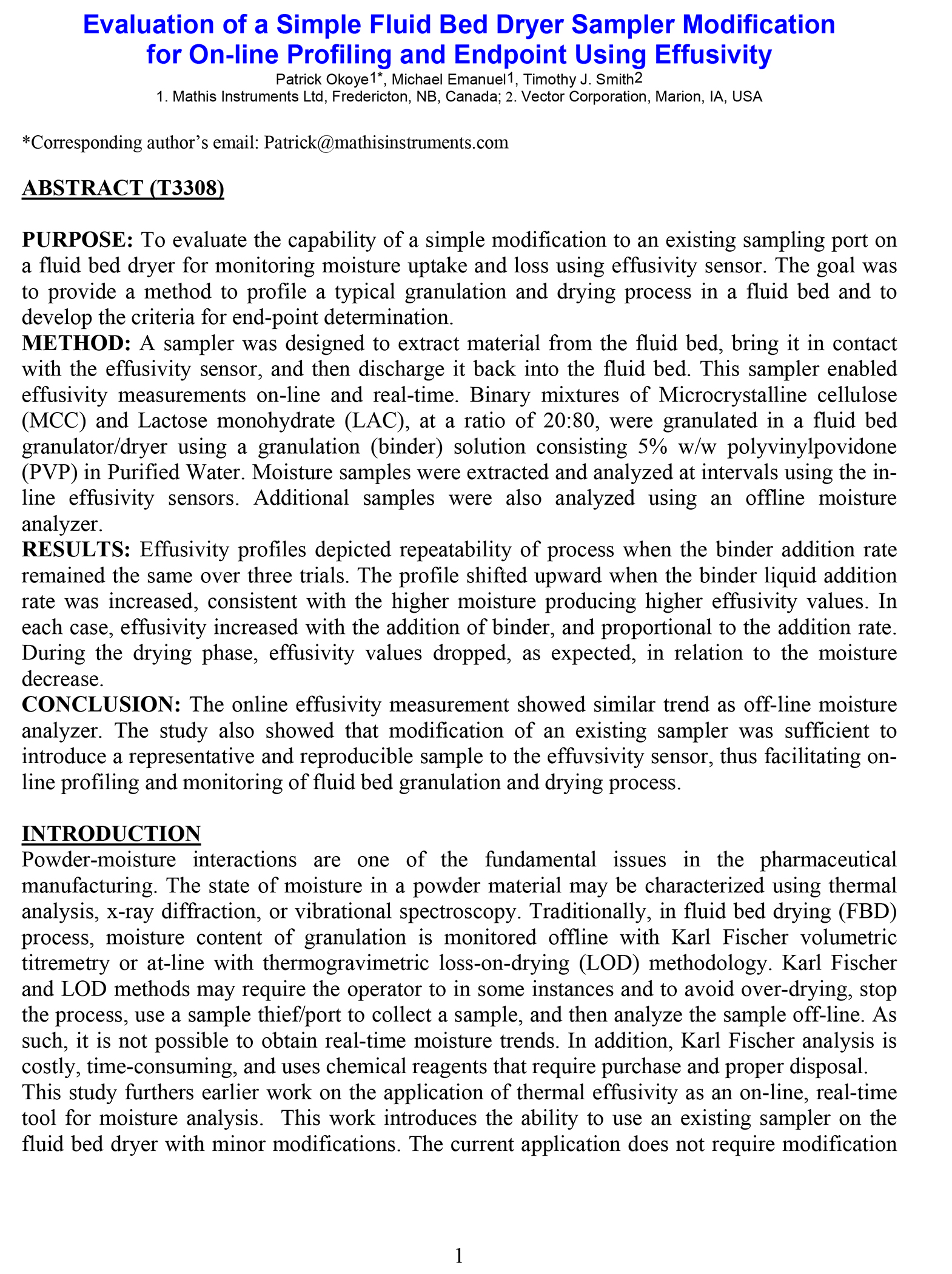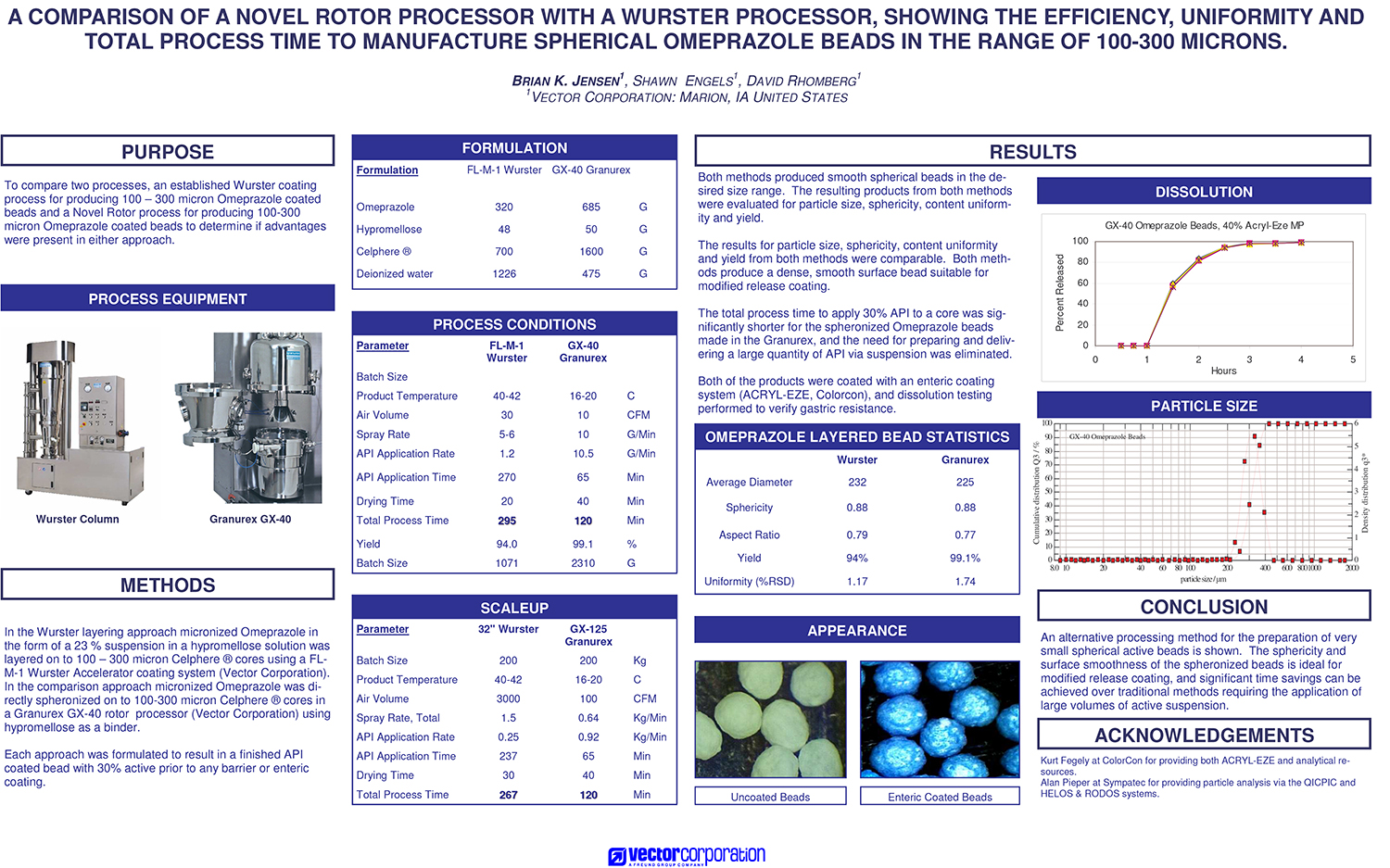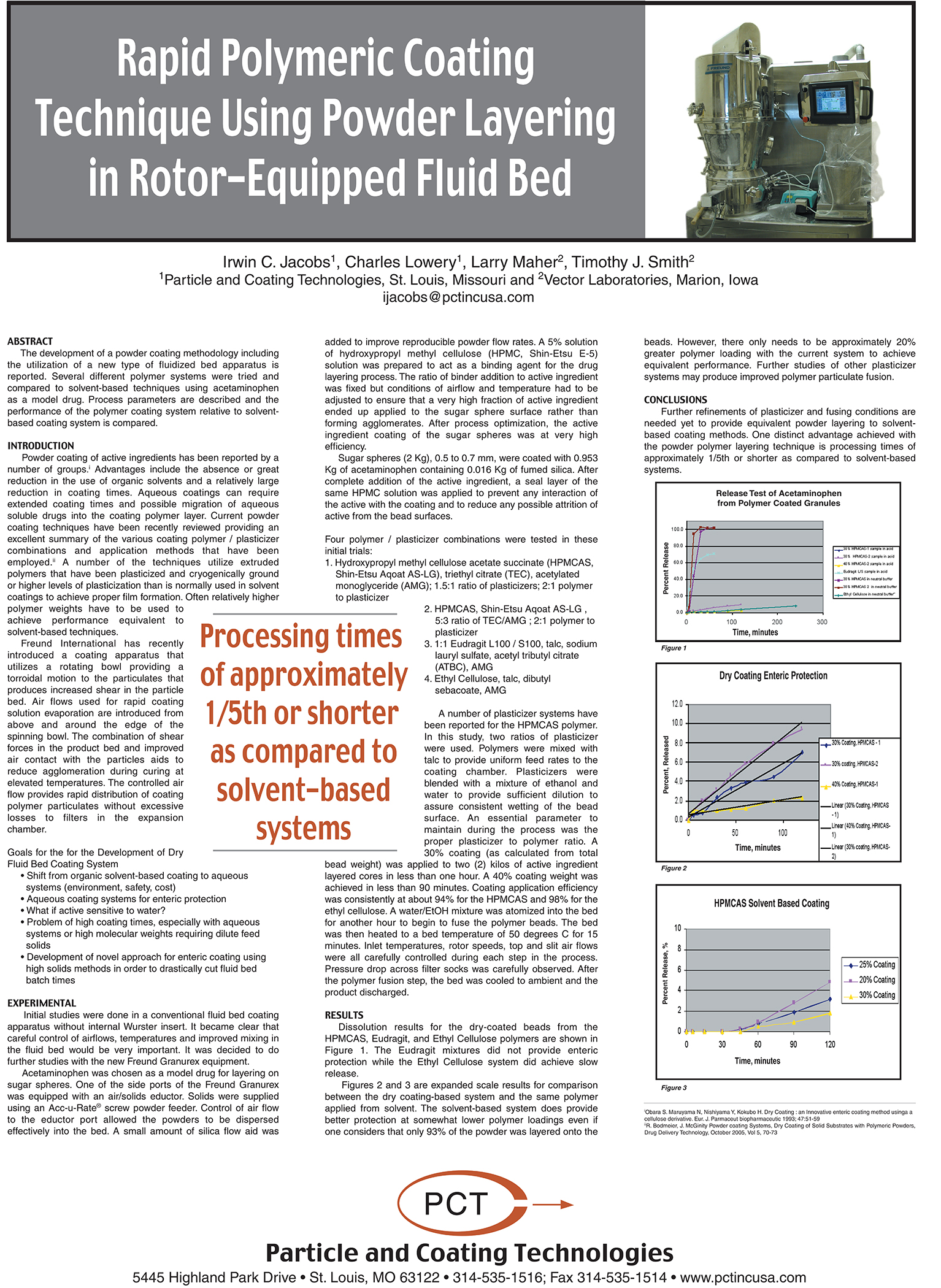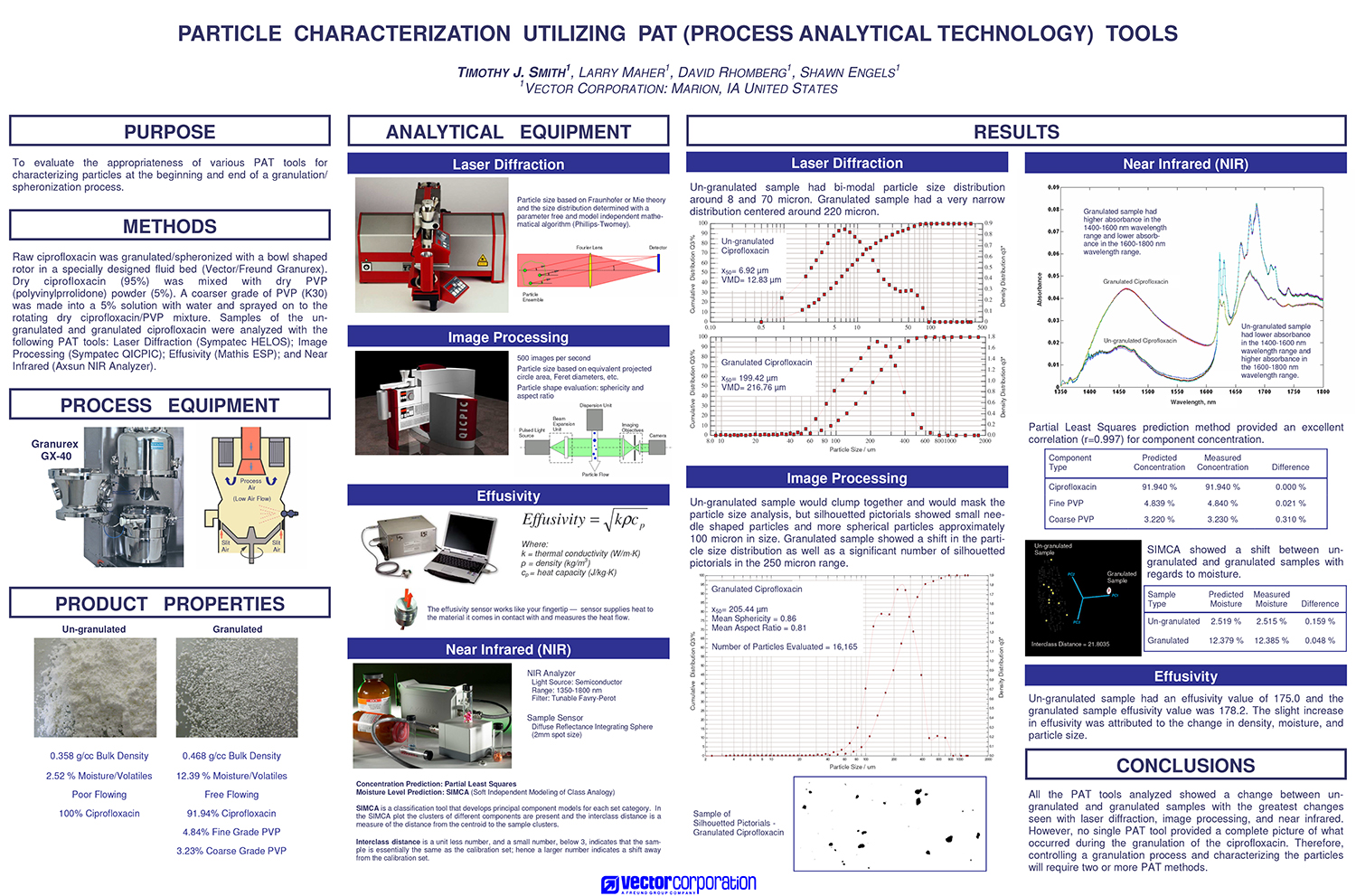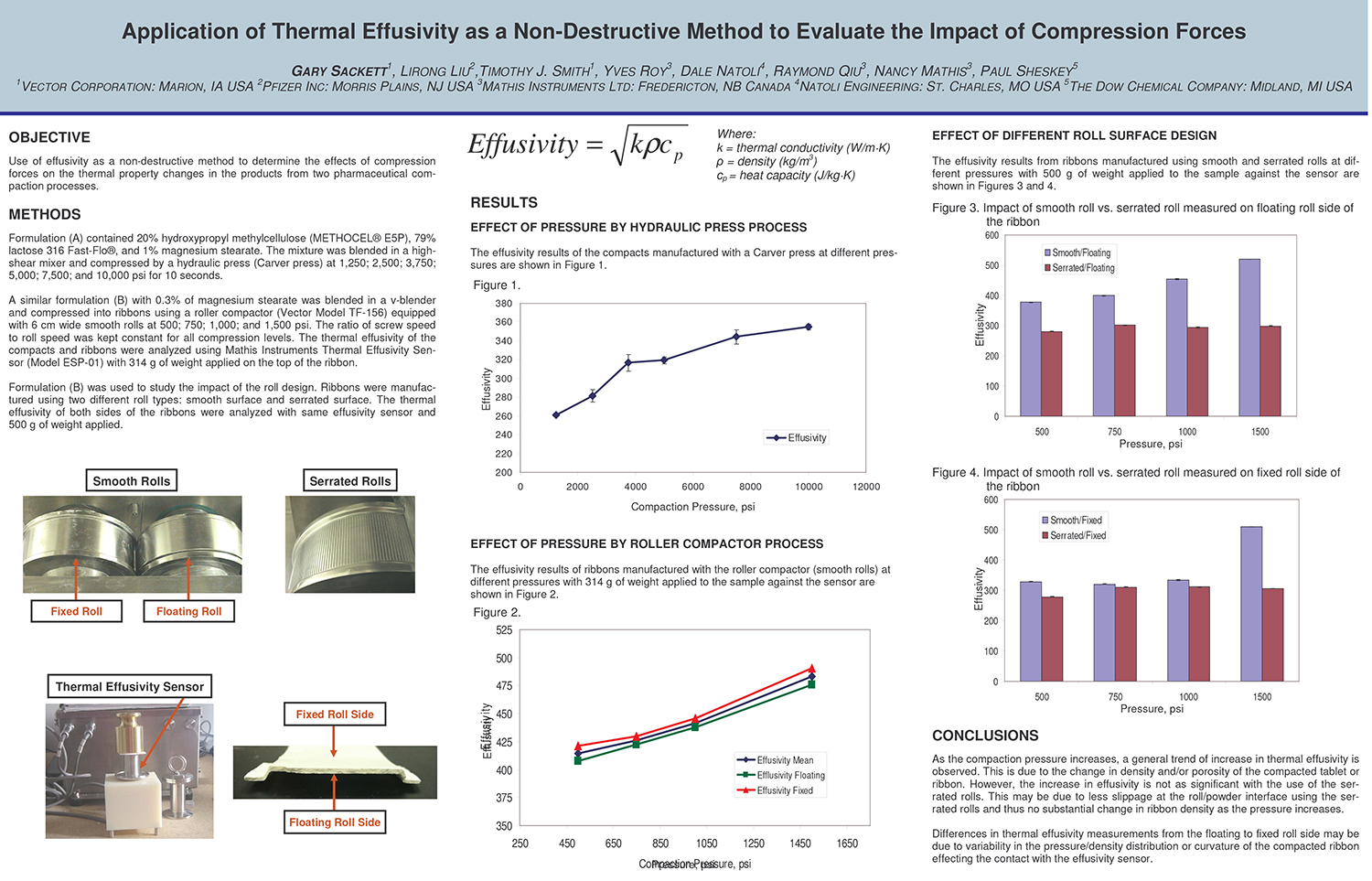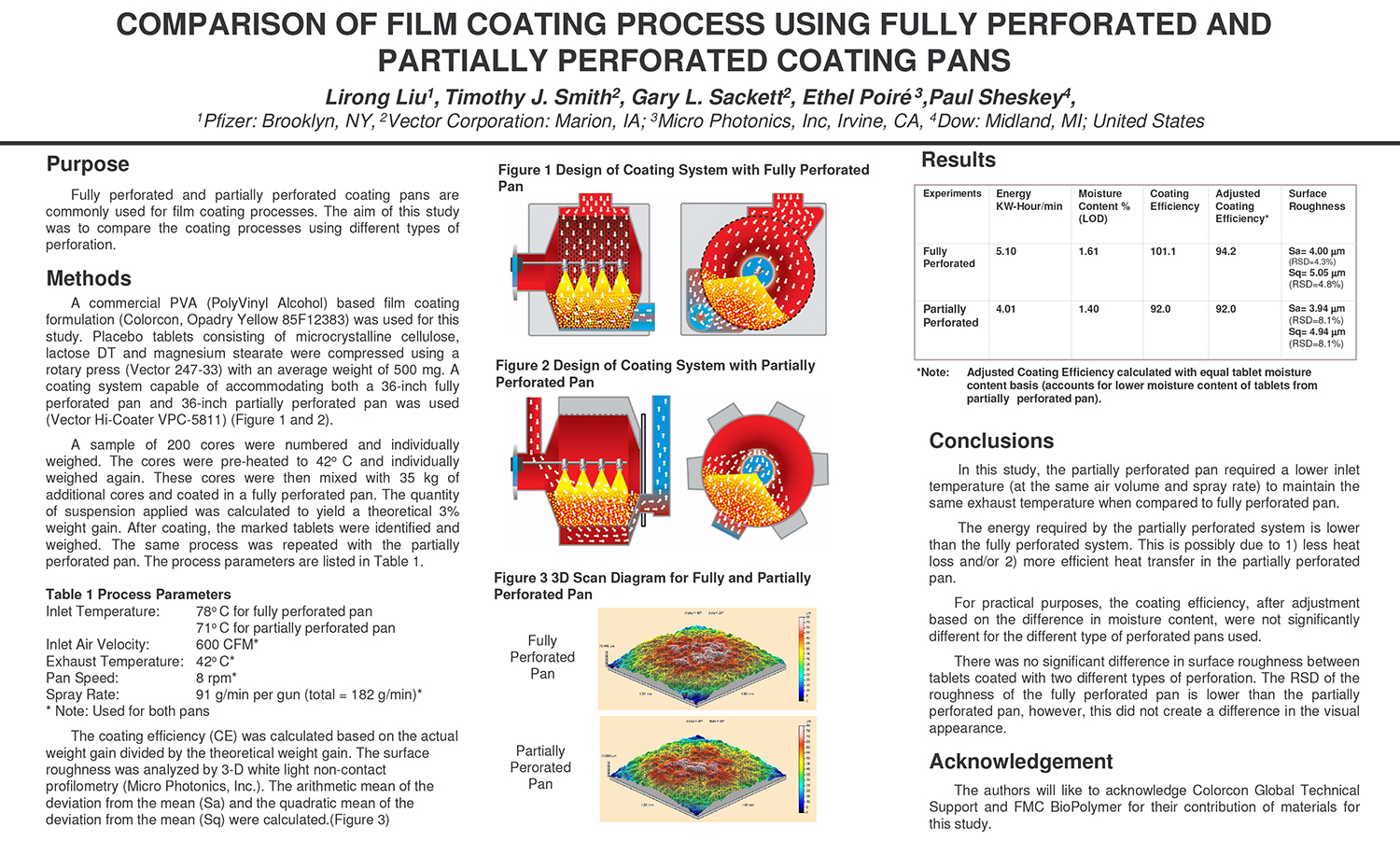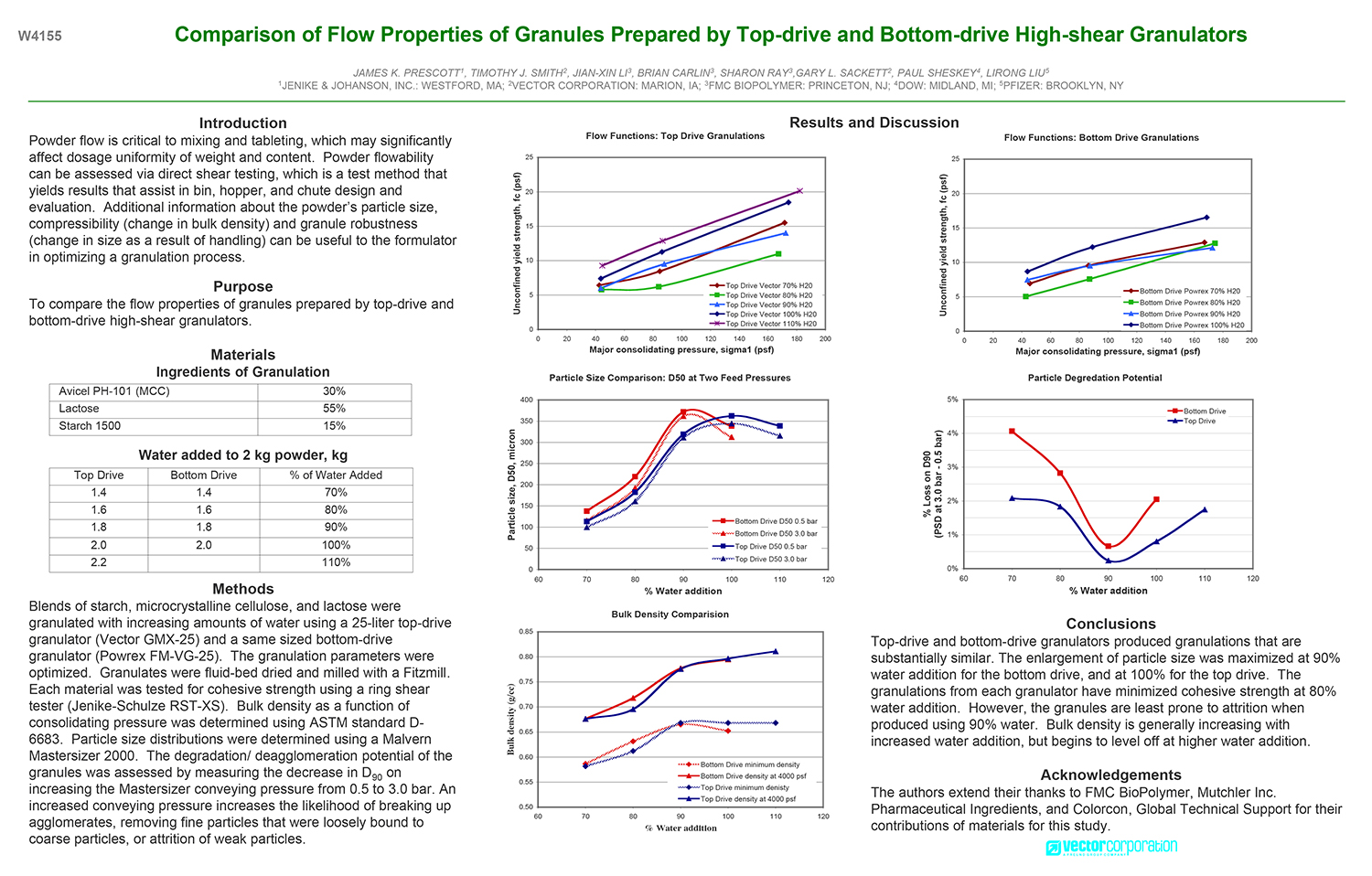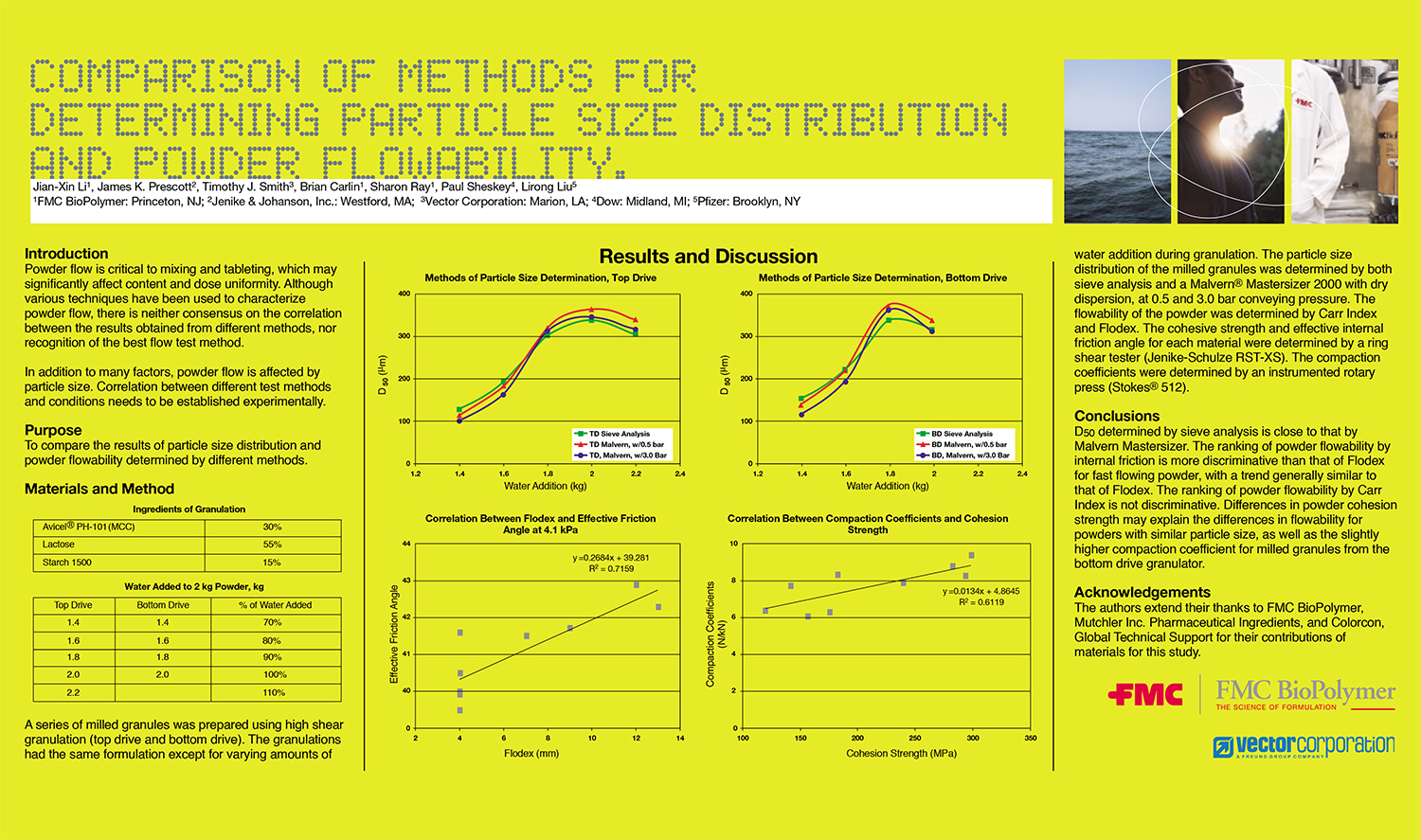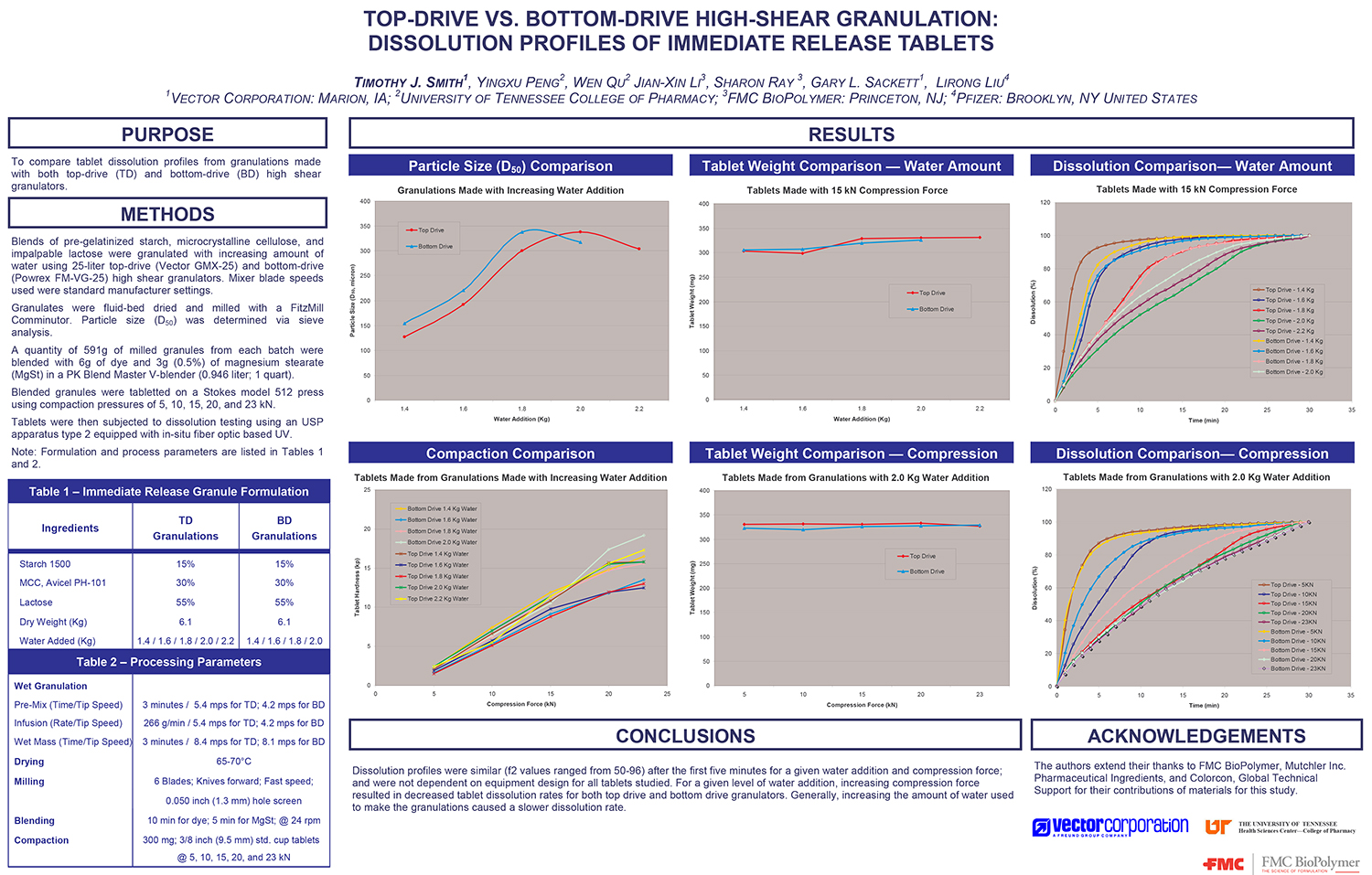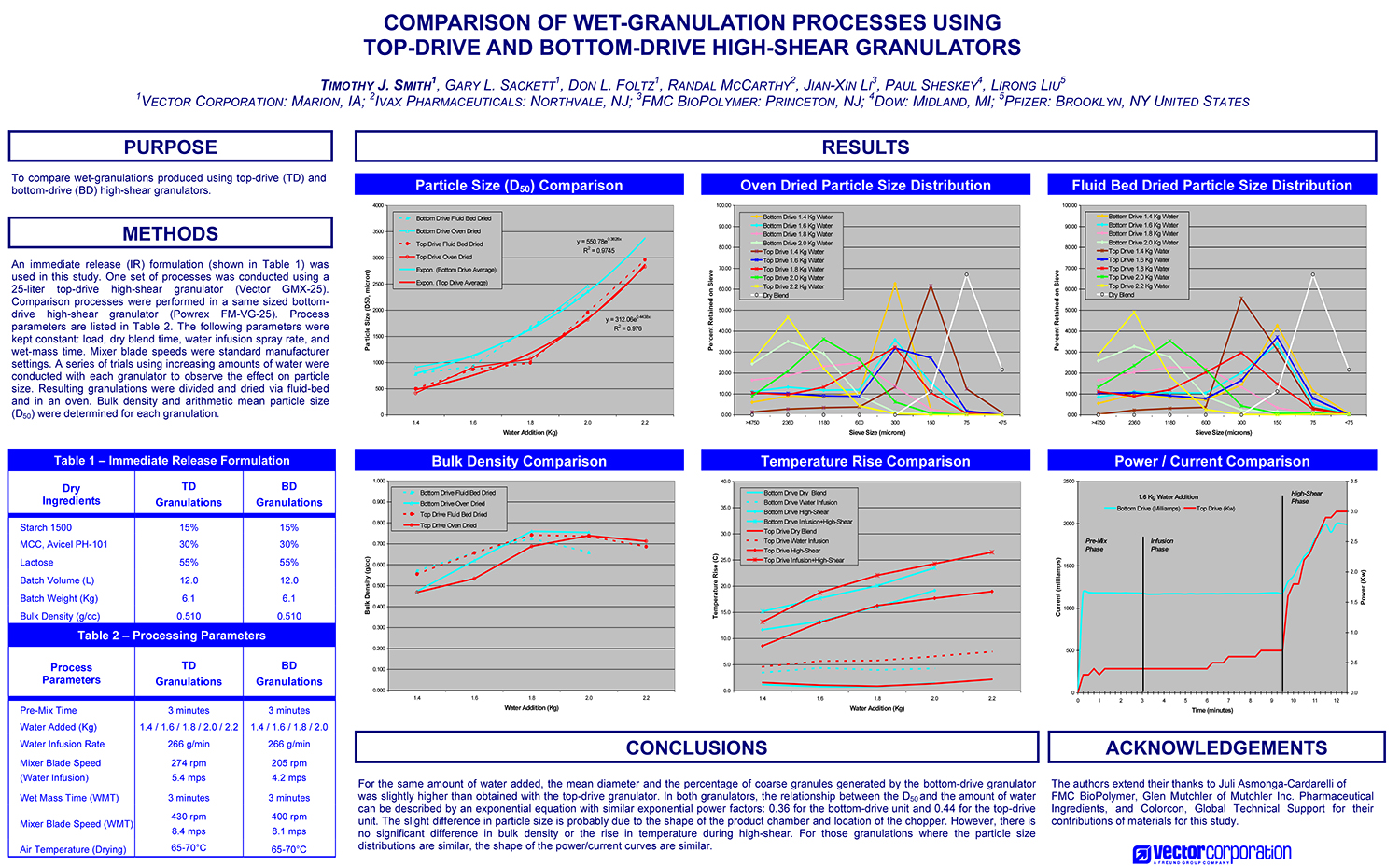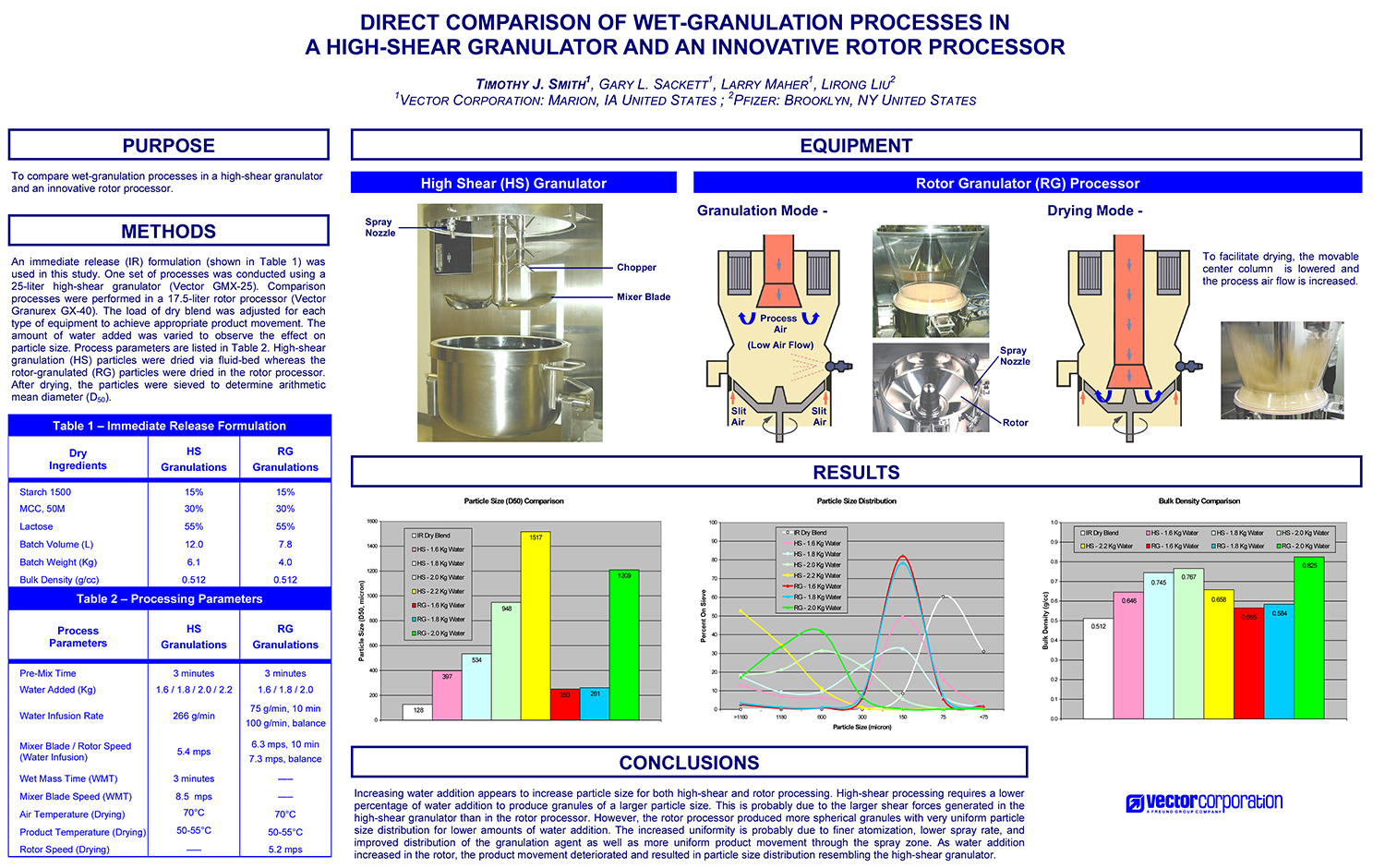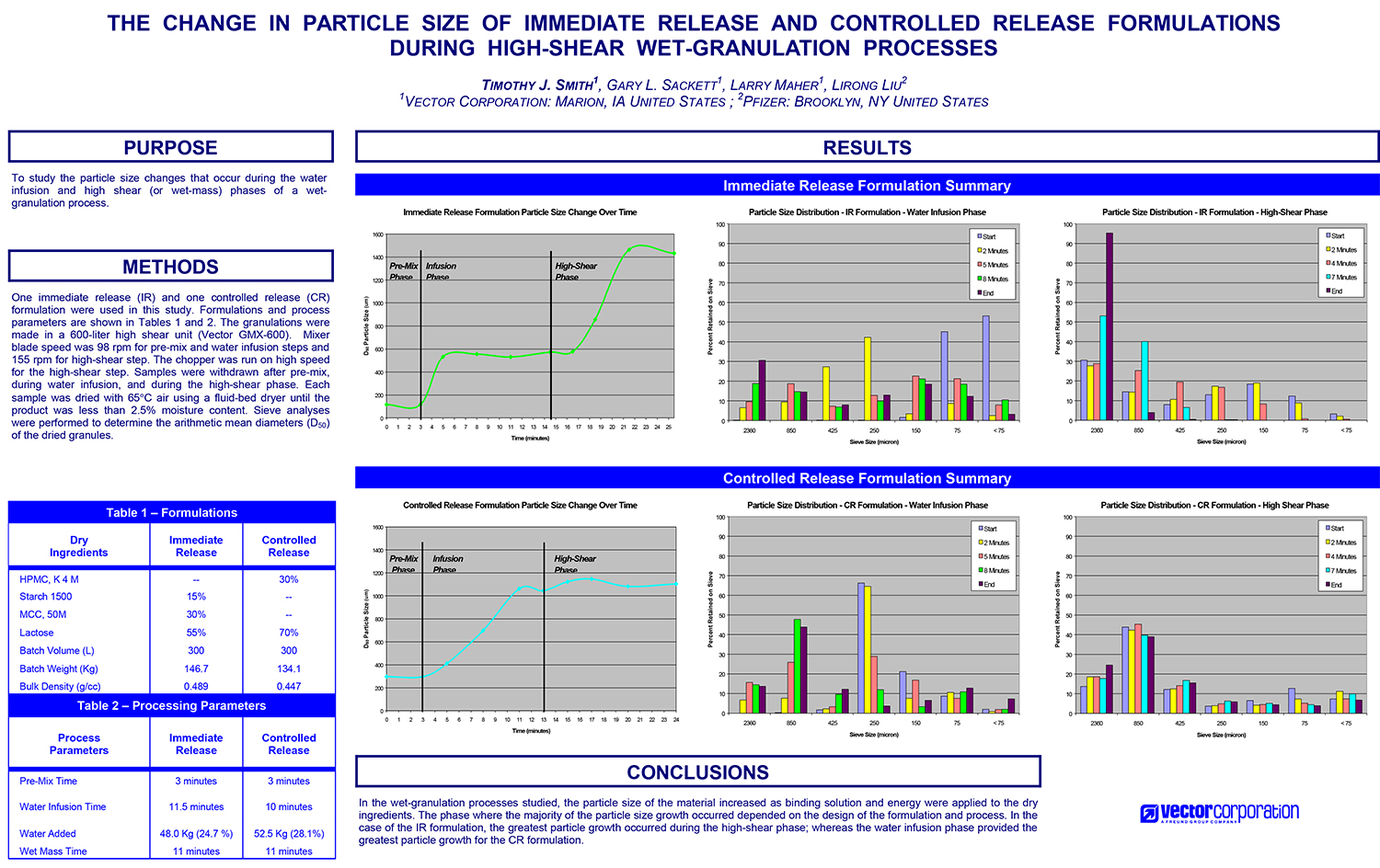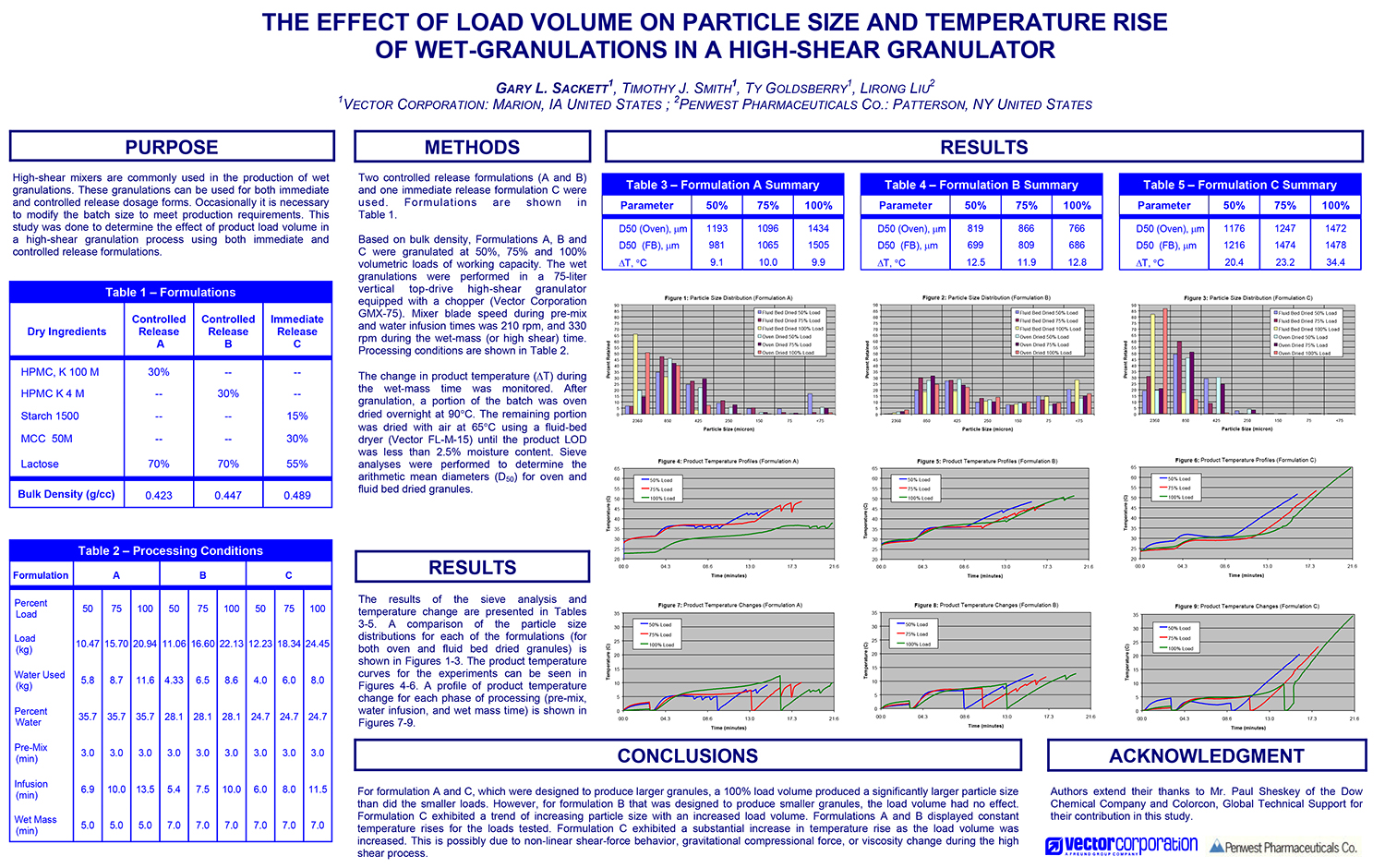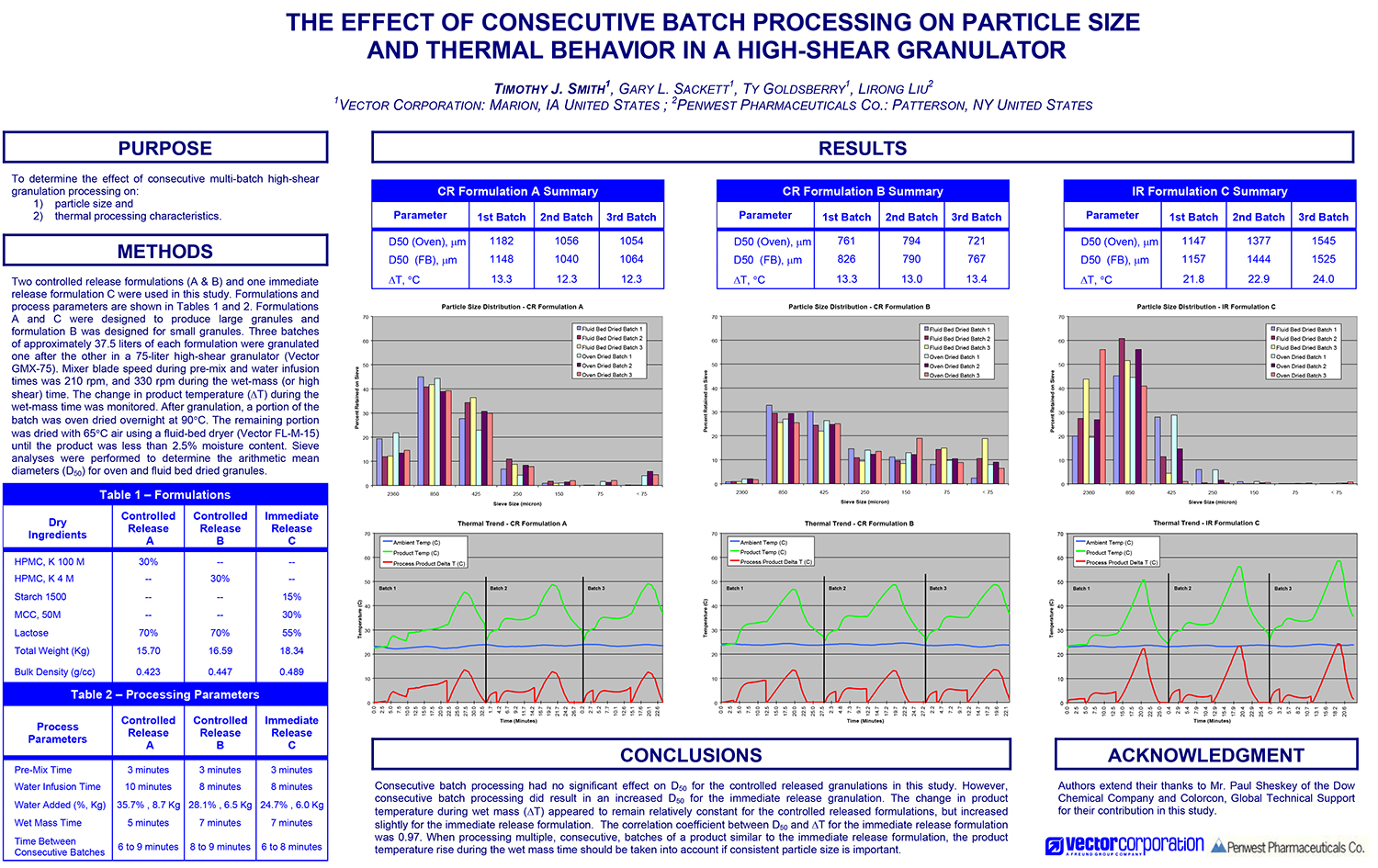
Evaluation of Lab vs Pilot Scale High Shear Granulation for Extended Release Tablets Containing Carbopol 971P Polymer
To evaluate the aqueous granulation process for guaifenesin formulations containing mid or high levels of Carbopol® 971P NF polymer (10% or 20% w/w) and to determine the effect of processing equipment (lab- vs. pilot-scale) on the granule and tablet properties and on drug release.
High Shear Granulation of Extended Release Tablets Containg Carbopol 971P NF Polymer in Top vs Bottom Drive Mixers
To evaluate aqueous granulation of guaifenesin formulations containing high level of Carbopol® 971P NF polymer (20% w/w) in pilot-scale top-drive vs. bottom-drive granulators, and compare the properties of the granules, tablets obtained by the two processes.
Processing of Extended Release Tablets Containing Carbopol® 971P NF Polymer by Top-Drive High Shear
To evaluate the aqueous granulation process in a pilot-scale top-drive high shear granulator for guaifenesin formulations containing (10% or 20% w/w) Carbopol® 971P NF polymer and to determine the effect of processing conditions on the granule and tablet properties and on drug release.
Novel Rotary Granulation Process (SFC) as an Alternative to Top Spray Granulation
Rotary granulation has been viewed as a favorable granulation method in the industry due to the uniformity and round shape of the granulations produced. It has failed to gain wide use as a production method due to small batch sizes and limited drying capabilities that can lead to long processing times. A novel screened rotary fluid bed insert with dual airflows combines the large batch size and drying capacity of the top spray fluid bed process with the size and shape uniformity of the traditional rotor process.
Impact of the Design of Spray Guns on a Pharmaceutical Film Coating Process
This study is to evaluate the impact of the design of spray guns on a pharmaceutical film coating process.
Effect of Different Solubilizers on Poorly Soluble Drug in DC Formulation Using High Shear Granulator
The objective of this study was a comparative investigation of release profiles of a poorly soluble model drug, carbamazepine, by the dry granulation method using Poloxamers as the solubilizing agents. The solubilizing capacity of Poloxamers 237 and 338 (Kolliphor™ P 237 and P 338, respectively) were compared to Poloxamer 188 and 407 (Kolliphor™ P 188 and P 407 respectively) in dry granulation using High Shear Granulator. The study involved carbamazepine as a model poorly – water soluble drug, and the mixture of various excipients’ particles using a high shear mixer granulator. The robustness of this dry granulation method in DC formulation is measured by the release profile of the drug solubilized by each of the Poloxamers.
Effect of Mixing Time on the Solubilization Of Poorly, Water Soluble Drug in DC Formulation, Using Soluplus® in High Shear Granulator
This investigation analyzed the solubilization capacity of Soluplus® in dry granulation. Soluplus® is a novel, graft copolymer of polyvinyl caprolactam – polyvinyl acetate – polyethylene glycol. Carbamazepine was used as a model drug, and the homogeneity of the mixture of various excipients’ particles in the high shear mixing bowl was determined. The robustness of dry granulation method in DC formulation was measured by the content uniformity of the mixture at a given length of mixing time and quantified by the percent of drug released at different sample points and levels (top and bottom).
Evaluation of a One-Step vs. Multi-Step Milling Process for Roller Compacted Ribbon
The purpose of this study was to evaluate the effectiveness of a two-step milling process vs. a one step milling process for a roller compacted ribbon and to quantify the effect on
overall particle size distribution.
Particle Coating – Tablets and Capsules Magazine
The article presents several brief case studies that describe how conical rotor technology can apply APIs and other dry powders to small core for use in multiparticulate dosage forms.
Scale up of a Mesalamine Dry Powder Drug Layering Process Utilizing a Conical Rotor Fluid Bed Insert
The purpose of this study was to transfer a dry powder layering process from a lab scale 1.5 KG batch to a production scale 50 KG batch in a conical rotor fluid bed insert.
Comparison of a Theophylline Powder Layering Process Utilizing SugarStarch cores and Novel MaltodextrinStarch Cores
To compare the processing and results of using two different core materials, sugar/starch cores and maltodextrin/starch cores, in a dry powder layering process of theophylline.
Effect of Plasticizer Systems with Eudragit® L-100 & S-100 on the Enteric Protection of Theophylline Beads Utilizing a Rotor Dry Layering Method
To investigate the effect of different plasticizer systems on the enteric protection of Theophylline multi-particulate beads coated with Eudragit® L-100 and Eudragit® S-100 polymers in dry form.
Novel Rotor-Granulator Powder Layering Process to Obtain Sustained Release Pellets with EUDRAGIT RS PO
EUDRAGIT® polymers have been widely known for their sustained release properties when used in coating and matrix applications. This study explores the use of EUDRAGIT® RS PO in a novel dry powder layering process to achieve sustained release pellets. Further a need of reducing the particle size of commercially marketed EUDRAGIT® RS PO is investigated.
Investigation of Effect of Plasticizer Systems with Micronized RS PO on the Release Profile of Theophylline Beads Using Conical Rotor
To investigate the effect of different plasticizer systems on the release profile of Theophylline multi-particulate beads coated with micronized RSPO polymer in dry form.
Optimization of Wurster Process to Create Omeprazole Pellets with Conical Rotor
The purpose of this study was to take an existing Wurster process that created enteric coated omeprazole beads on a Wurster and transfer it to a conical rotor to reduce the processing time and pieces of equipment required to complete the process.
Raman Chemical Imaging – Drug Delivery Technology
Site-specific delivery and controlled release of active pharmaceutical ingredients (APIs) have resulted in a high demand for modified-release products. Sustained-release beads can deliver stable levels of drugs, which result in less-frequent dosing. For consistent drug delivery, it is imperative for the bead coating to be uniformly applied. In this study, Raman Chemical Imaging (RCI) coupled with optical microscopy was applied to investigate API and polymer coating thicknesses in commercial sustained-release beads. This approach was compared to scanning electron microscopy (SEM) and dissolution data obtained for the same batch.
Coating Process Step Deviations Monitored via use of a Graphical Imaging Tool
To study the particle size and shape changes during coating of ibuprofen coated beads and determine if process changes could be detected.
Investigation of Effect of Plasticizer Systems with Eudragit E PO Applied to APAP Beads via Rotor Process
The purpose of this study was to determine the effect of two different plasticizer systems on the film formation and overall processablilty of Eudragit E PO during a dry powder coating.
Novel Rotor-Granulator Powder Layering Technique of Eudragit E PO to Taste Mask APAP Pellets
The purpose of this study was to investigate the taste masking of acetaminophen beads with EUDRAGIT® E PO powder utilizing a novel, low temperature rotor-granulator process.
Processing Changes Monitored During Spheronization and Powder Layering via use of a Graphical Imaging Tool
To study the particle size and shape changes during rotor spheronization of starch and lactose and powder layering of ibuprofen onto sugar cores.
Comparison of Binder Addition on Particle Size and Shape for High Shear Granulations
To study the effects on particle size and shape for high-shear granulation using differing means of binder activation.
Rotor Process to Apply MMA to Multi-Particulates
To develop a novel process for applying methylmethacrylates (MMA) to multi-particulates using a rotor processor.
Wurster vs Rotor Efficiency, Uniformity, and Total Process Time for Sustained Release APAP Beads
To compare two methods for applying a sustained release polymer to acetaminophen beads and identify processing time, efficiency, solvent usage and dissolution results.
APAP Enteric-Sustained Release Beads via Rotor with Dry Powder
To develop a method for quickly and efficiently coating dry polymer onto beads using a rotor processor without the use of organic solvents.
Wurster vs Rotor Efficiency, Uniformity, and Total Process Time for Sustained Release APAP Beads
To compare two methods for applying a sustained release polymer to acetaminophen beads and identify processing time, efficiency, solvent usage and dissolution results.
Evaluation of a Simple FBD Sampler Modification for On-Line Profiling and Endpoint Using Effusivity
To evaluate the capability of a simple modification to an existing sampling port on a fluid bed dryer for monitoring moisture uptake and loss using effusivity sensor. The goal was to provide a method to profile a typical granulation and drying process in a fluid bed and to develop the criteria for end-point determination.
Novel Rotor GXR Process – 100-300 Micron APAP Beads via Spheronization-Powder Layering
This study compared two processes used for the rapid production of high active content spherical beads: 1. Spherical Granulation without the use of a core particle, and 2. Dry Powder Layering, utilizing a core particle. Both approaches use a minimum of a simple binder solution to show the application efficiency, size uniformity, content uniformity and total process time to manufacture spherical beads suitable for coating for modified release.
Novel Rotor GXR vs Wurster Process 100-300 Micron Omeprazole Beads
To compare two processes, an established Wurster coating process for producing 100 – 300 micron Omeprazole coated beads and a Novel Rotor process for producing 100-300 micron Omeprazole coated beads to determine if advantages were present in either approach.
Optimization of Cold Water Starch Granulations using High Shear Methods with fully Pregelatinized Starch as Dry Binder
Traditional starch granulations require starch paste preparation which takes time and presents a hazard to the operator in terms of steam heating and the handling of the very hot liquids.
Particle and Coating Tech/Rapid Polymeric Coating Technique Using Powder Layering in Rotor
The development of a powder coating methodology including the utilization of a new type of fluidized bed apparatus is reported. Several different polymer systems were tried and
compared to solvent-based techniques using acetaminophen as a model drug. Process parameters are described and the performance of the polymer coating system relative to solvent based coating system is compared.
Particle Characterization Utilizing PAT (Process Analytical Technology) Tools
To evaluate the appropriateness of various PAT tools for characterizing particles at the beginning and end of a granulation/spheronization process.
Application of Thermal Effusivity as a Non-Destructive Method to Evaluate the Impact of Compression Forces
Use of effusivity as a non-destructive method to determine the effects of compression forces on the thermal property changes in the products from two pharmaceutical compaction
processes.
Impact of Different Roll Sizes on Roller Compactor Granulations
To determine if constant linear roll face speed and compaction force/unit length (across roll width) would yield similar granulations from two different sized roller compactor rolls.
Comparison of Film Coating Process using Fully Perforated and Partially Perforated Coating Pans
Fully perforated and partially perforated coating pans are commonly used for film coating processes. The aim of this study was to compare the coating processes using different types of perforation.
Comparison of Flow Properties of Granules Prepared by Top-Drive & Bottom-Drive High Shear Granulatotors
To compare the flow properties of granules prepared by top-drive and bottom-drive high-shear granulators.
Comparison of Methods for Determining Particle Size Distribution and Powder Flowability
To compare the results of particle size distribution and powder flowability determined by different methods.
Top-Drive vs Bottom-Drive High-Shear Granulation-Dissolution Profiles of Immediate Release Tablets
To Compare Tablet Dissolution Profiles from Granulation made with both Top-Drive (TD) and Bottom-Drive (BD) High Shear Granulators.
Top vs Bottom Drive Granulation Properties of IR Formulation
To compare top-drive (TD) high shear granulation versus bottom-drive (BD) high-shear granulation.
Comparison of Wet Granulations from Top and Bottom Drive High Shear Mixers
To compare wet-granulations produced using top-drive (TD) and bottom-drive (BD) high-shear granulators.
High-Shear and Innovative Rotor Granulator
To compare wet-granulation processes in a high-shear granulator and an innovative rotor processor.
Change in Particle Size of IR and CR Formulations in High Shear Granulations
To study the particle size changes that occur during the water infusion and high shear (or wet-mass) phases of a wet granulation process.
Comparison of End-Point Determination for IR and CR High Shear Formulations
To determine the most effective end-point method for scale-up of wet granulations using the following methods: 1) Wet-mass time (WMT) 2) Product temperature change (DT) 3) Peak power consumption (KWp)
The Effect of Consecutive Batch Processing on Particle Size and Thermal Behavior in a High-Shear Granulator
To incorporate wet-mass, or high shear, mixer blade power consumption information.
Effect of Load Volume on PSD and Temperature in High Shear Granulations
High-shear mixers are commonly used in the production of wet granulations. These granulations can be used for both immediate and controlled release dosage forms. Occasionally it is necessary to modify the batch size to meet production requirements. This study was done to determine the effect of product load volume in a high-shear granulation process using both immediate and controlled release formulations.
Effect of Consecutive Batch Processing on PSD and Thermal Behavior in High Shear Granulator
To determine the effect of consecutive multi-batch high-shear granulation processing on: 1) particle size and 2) thermal processing characteristics


